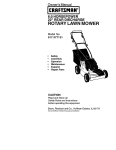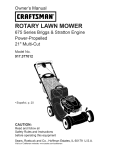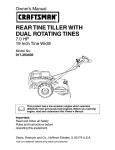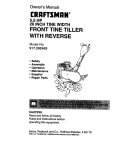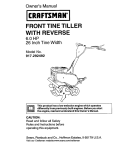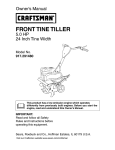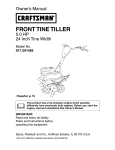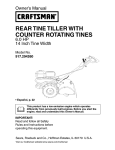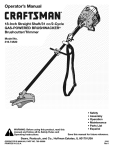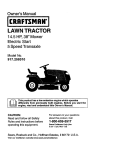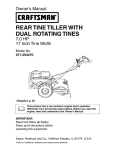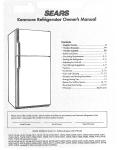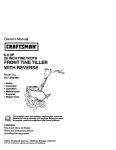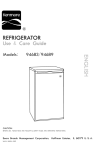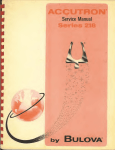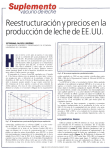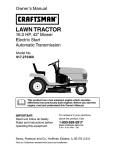Download Craftsman 917.292493 Owner`s manual
Transcript
Owner's Manual
ICReFT=M.Wl
FRONTTI
TILLE
WITH REVERSE
6.0 HP
26 Inch Tine Width
Model No.
917.292493
This product has a low emission engine which operates
[_]]]
differently from previously built engines. Before you start
the engine, read and understand this Owner's Manual.
IMPORTANT:
Read and follow all Safety
Rules and Instructions before
operating this equipment.
Sears, Roebuck and Co., Hoffman Estates,
Visit our Craftsman website:www.sears.com/craftsman
IL 60179 U.S.A.
Warranty
................................................
Maintenance Schedule ........................ 11
Service and Adjustments ..................... 13
Storage ................................................
16
Troubleshooting ...................................
17
Illustrated Parts List ............................. 37
Sears Service ........................ Back Cover
2
Safety Rules ..........................................
2
Product Specifications
......................... 4
Assembly ...............................................
6
Operation ...............................................
7
Maintenance ........................................
11
LIMITED TWO YEAR WARRANTY ON CRAFTSMAN TILLER
For two (2) years from date of purchase, when this Craftsman Tiller is maintained,
lubricated, and tuned up according to the operating and maintenance instructions in the
owner's manual, Sears will repair free of charge any defect in material or workmanship.
This Warranty does not cover:
• Expendable items which become worn during normal use, such as tines, spark plugs,
air cleaners and belts.
• Repairs necessary because of operator abuse or negligence, including bent crankshafts and the failure to maintain the equipment according to the instructions contained in the owner's manual.
• If this Craftsman Tiller is used for commercial or rental purposes, this Warranty applies
for only thirty (30) days from the date of purchase.
Warranty service is available by returning the craftsman power mower to the nearest
sears service center/department in the united states. This warranty applies only while
this product is in use in the united states.
This Warranty gives you specific legal rights, and you may also have other rights which
vary from state to state.
SEARS, ROEBUCK AND CO., D/817WA, HOFFMAN ESTATES, IL 60179
IMPORTANT: This cutting machine is capable of amputating hands and feet and throwing objects. Failure to observe the following safety instructions could result in serious
injury or death.
TRAINING
• Disengage all clutches and shift into
neutral before starting the engine (motor).
• Do not operate the equipment without
wearing adequate outer garments. Wear
footwear that will improve footing on
slippery surfaces.
• Handle fuel with care; it is highly flammable.
• Use an approved fuel container.
• Never add fuel to a running engine or
hot engine.
• Fill fuel tank outdoors with extreme care.
Never fill fuel tank indoors.
• Replace gasoline cap securely and
clean up spilled fuel before restarting.
• Read the Owner's Manual carefully. Be
thoroughly familiar with the controls and
the proper use of the equipment. Know
how to stop the unit and disengage the
controls quickly.
• Never allow children to operate the
equipment. Never allow adults to operate the equipment without proper
instruction.
• Keep the area of operation clear of all
persons, particularly small children, and
pets.
PREPARATION
• Thoroughly inspect the area where the
equipment is to be used and remove all
foreign objects.
2
• Use extension cords and receptacles
as specified by the manufacturer for all
units with electric drive motors or electric starting motors.
• Never attempt to make any adjustments
while the engine (motor) is running (except where specifically recommended
by manufacturer).
• Do not overload the machine capacity
by attempting to till too deep at too fast
a rate.
• Never operate the machine at high
speeds on slippery surfaces. Look behind and use care when backing.
• Never allow bystanders near the unit.
• Use only attachments and accessories
approved by the manufacturer of the
tiller.
• Never operate the tiller without good visibility or light.
• Be careful when tilling in hard ground.
The tines may catch in the ground and
propel the tiller forward. If this occurs,
let go of the handlebars and do not
restrain the machine.
OPERATION
• Do not put hands or feet near or under
rotating parts.
• Exercise extreme caution when operating on or crossing gravel drives, walks,
or roads. Stay alert for hidden hazards
or traffic. Do not carry passengers.
• After striking a foreign object, stop the
engine (motor), remove the wire from
the spark plug, thoroughly inspect the
tiller for any damage, and repair the
damage before restarting and operating
the tiller.
• Exercise caution to avoid slipping or falling.
• If the unit should start to vibrate abnormally, stop the engine (motor) and
check immediately for the cause. Vibration is generally a warning of trouble.
• Stop the engine (motor) when leaving
the operating position.
• Take all possible precautions when leaving the machine unattended. Disengage
the tines, shift into neutral, and stop the
engine.
• Before cleaning, repairing, or inspecting,
shut off the engine and make certain all
moving parts have stopped. Disconnect
the spark plug wire, and keep the wire
away from the plug to prevent accidental
starting. Disconnect the cord on electric
motors.
• Do not run the engine indoors; exhaust
fumes are dangerous.
• Never operate the tiller without proper
guards, plates, or other safety protective
devices in place.
• Keep children and pets away.
MAINTENANCE
AND STORAGE
• Keep machine, attachments, and accessories in safe working condition.
• Check shear pins, engine mounting
bolts, and other bolts at frequent intervals for proper tightness to be sure the
equipment is in safe working condition.
• Never store the machine with fuel in the
fuel tank inside a building where ignition
sources are present, such as hot water
and space heaters, clothes dryers, and
the like. Allow the engine to cool before
storing in any enclosure.
• Always refer to the operator's guide
instructions for important details if the
tiller is to be stored for an extended
_iP eriod.
Look for this symbol to point out
important safety precautions. It means
CAUTION!H BECOME ALERT!H YOUR
SAFETY IS INVOLVED.
_,CAUTION: Always disconnect spark
plug wire and place wire where it cannot
contact spark plug in order to prevent accidental starting when setting up, transporting, adjusting or making repairs.
_I4LWARNING: Engine exhaust, some of its
constituents, and certain vehicle components contain or emit chemicals known to
the State of California to cause cancer and
birth defects or other reproductive harm.
3
PRODUCT
SPECIFICATIONS
iGasoline
iCapacity:
Oil (API-SF-SJ):
(Capacity: 20 oz.)
Spark Plug :
(Gap: .030")
CUSTOMER
RESPONSIBILITIES
= Read and observe the safety rules.
= Follow a regular schedule in maintaining, caring for and using your tiller.
= Follow the instructions under the "Maintenance" and "Storage" sections of this
Owner's Manual.
_,WARNING:
This unit is equipped with
an internal combustion engine and should
not be used on or near any unimproved
forest-covered, brush-covered or grass
covered land unless the engine's exhaust
system is equipped with a spark arrester
meeting applicable local or state laws (if
any). If a spark arrester is used, it should
be maintained in effective working order
by the operator.
In the state of California the above is
required by law (Section 4442 of the
California Public Resources Code). Other
states may have similar laws. Federal
laws apply on federal lands. A spark arrester for the muffler is available through
your nearest Sears service center (See
REPAIR PARTS section of this manual).
3 Quarts
Unleaded Regular
SAE 30
(Above 32°F)
SAE 5W-30
(Below 32°F)
Champion
RC12YC
CONGRATULATIONS
on your purchase
of a Sears Tiller. It has been designed,
engineered and manufactured to give you
the best possible dependability and performance.
Should you experience any problems you
cannot easily remedy, please contact a
Sears or other qualified Service Center.
We have competent, well-trained technicians and the proper tools to service or
repair this unit.
Please read and retain this manual. The
instructions will enable you to assemble
and maintain your tiller properly. Always
observe the "SAFETY RULES".
Your new tiller has been assembled at the
factory with exception of those parts left
unassembled for shipping purposes. To
ensure safe and proper operation of your
tiller all parts and hardware you assemble
must be tightened securely. Use the correct tools as necessary to insure proper
tightness.
These accessories were available when the tiller was purchased. They are also available at most Sears Retail outlets and Service Centers. Most Sears Stores can order
repair parts for you when you provide the model number of your tiller.
ENGINE
_PARK PLUG
MUFFLER
AIR FILTER
GAS CAN
ENGINE OIL
STABILIZER
TILLER MAINTENANCE
BELT
TINES
SHEAR PIN
4
HAIRPIN CLIP
Your new tiller has been assembled at the
factory with the exception of those parts
left unassembled for shipping purposes. To
ensure safe and proper operation of your
tiller all parts and hardware you assemble
must be tightened securely. Use the correct tools as necessary to insure proper
tightness.
TOOLS REQUIRED
ASSEMBLY
Front
F ,-I
FOR
A socket wrench set will make assembly
easier. Standard wrench sizes are listed.
(1) Utility knife
(1) Screwdriver
(1) Pair of pliers
(2) 1/2" wrenches
OPERATOR'S POSITION
When right or left hand is mentioned in
this manual, it means when you are in the
operating position (standing behind tiller
handles).
CONTENTS
Left
_
Right
Operator's Position
OF HARDWARE
PACK
Q
(2) Carriage Bolts
5/16-18 UNC x 2-1/2
(2) Flange
Locknuts
5/16-18 UNC
(1) Manual
Q
i_l
(2) Hex Bolt
5/16-18 x 1-1/4
(1) Bottle
Engine Oil
5
(2) Lock
Washer
5/16
(2) Hex Nut
5/16-18
INSTALL DEPTH STAKE
ASSEMBLY
1. Loosen nut "A".
2. Insert stake support between engine
bracket halves with stake spring down.
3. Bolt stake support to engine brackets
with bolts, lock washers and nuts.
Tighten securely. Tighten nut "A".
4. Depth stake must move freely. If it does
not, loosen support bolt.
UNPACK CARTON & INSTALL
HANDLE
• LCAUTION: Be careful of exposed staples when handling or disposing of cartoning material.
IMPORTANT: When unpacking and assembling tiller, be careful not to stretch or kink
cable(s).
1. Cut cable ties securing handle column.
2. Route cable(s) as shown and slide
handle column onto handle mount.
3. Remove all packing from carton.
4. Secure handle column using two (2)
carriage bolts and two (2) flange locknuts. Tighten securely.
5. Cut away carton.
6. Route tine control cable(s) through
plastic cable clip on handle mount.
NOTE: Cables must not touch the muffler.
7. Cut cable ties securing tiller to skid.
Remove tiller from skid by pulling backwards.
8. Remove screws securing depth stake
to skid and discard the screws.
=ngine Bracket Halves
"_
Nut "A"
Depth
Stake
Depth
Stake
Support
Bolt
Stake Spring
Hex Bolts, Lock Washers,
and hex Nuts
Tine Control
Handle Mount
HANDLE
Tine Control
HEIGHT
Handle height may be adjusted to better
suit operator. (See "HANDLE HEIGHT'
in the Service and Adjustments section
of this manual).
Cables
Column
TILLING WIDTH
• Tilling width may be adjusted to better
handle your tilling conditions (See "TINE
ARRANGEMENT'
in the Service and
Adjustments section of this manual).
TINE OPERATION
• Check tine operation before first use.
(See "TINE OPERATION CHECK" in the
Service and Adjustments section of this
manual).
Carriage
Bolts
Flange
Locknuts
6
KNOW YOUR TILLER
READ THIS OWNER'S MANUAL AND SAFETY RULES BEFORE OPERATING YOUR
TILLER.
Compare the illustrations with your tiller to familiarize yourself with the location of various
controls and adjustments. Save this manual for future reference.
These symbols may appear on your Tiller or in literature supplied with the product. Learn and understand their meaning.
OR WARNING
ON
OFF
Reverse Tine Control
Forward Tine
Choke Control
Control
Depth Stake
e Shield
Tines
Sears tillers conform to the safety standards of the
American National Standards Institute.
FORWARD TINE CONTROL - Engages
tines in forward direction.
REVERSE TINE CONTROL - Engages
tines in reverse direction.
CHOKE CONTROL - Used when starting
a cold engine.
THROTTLE CONTROL - Controls engine
speed.
DEPTH STAKE - Controls forward speed
and the depth at which the tiller will dig.
RECOIL STARTER HANDLE - Used to
start the engine.
7
The operation of any tiller can result in foreign objects thrown into the eyes,
which can result in severe eye damage. Always wear safety glasses or eye
shields before starting your tiller and while tilling. We recommend standard
safety glasses or a wide vision safety mask worn over spectacles.
HOW TO USE YOUR TILLER
DEPTH
Know how to operate all controls before
adding fuel and oil or attempting to start
engine.
Adjust depth stake by removing the hairpin
clip and clevis pin. Change depth stake
to desired position. Replace the clevis pin
and hairpin clip.
• For normal tilling, set depth stake at the
second or third hole from the top.
STOPPING
TINES
1. Release forward tine control to stop
forward movement.
2. Release reverse tine control to stop
reverse movement.
ENGINE
• Move throttle control to "STOP" position.
NOTE: Never use choke to stop engine.
Reverse Tine Control
STAKE
WHEELS
Adjust wheels by removing the hairpin clip
and clevis pin. Change wheel position.
Replace the hairpin clip and clevis pin.
• For normal tilling, set wheels at the
second or third hole from the top.
Forward Tine Control
"OFF (UP) Position
Hairpin Clip
and Clevis Pin
Wheel
Forward Tine Control
"ON" (DOWN) Position
Stake_
Spring
Depth Stake
TO TRANSPORT
_I,CAUTION: Before lifting or transporting,
allow tiller engine and muffler to cool. Disconnect spark plug wire. Drain gasoline
from fuel tank.
AROUND THE YARD
Throttle
Control
Choke
1. Tip depth stake forward until it is held
by the stake spring.
2. Push tiller handles down, raising tines
off the ground.
3. Push or pull tiller to desired location.
AROUND TOWN
TINE OPERATION
FORWARD
• Squeeze forward tine control to handle.
REVERSE
• With forward tine control "OFF" (up)
position, pull back and hold reverse tine
control.
1. Disconnect
spark plug wire.
2. Drain fuel tank.
3. Transport in upright position
oil leakage.
TILLING
BEFORE
The speed and depth of tilling is regulated
by the position of the depth stake and
wheel height.
The depth stake should always be below
the wheels for digging. It serves as a
brake to slow the tiller's forward motion to
enable the tines to penetrate the ground.
Also, the more the depth stake is lowered
into the ground the deeper the tines will
dig.
IMPORTANT: Be very careful not to allow
dirt to enter the engine when checking or
adding oil or fuel. Use clean oil and fuel
and store in approved, clean, covered
containers, use clean fill funnels.
FILL ENGINE WITH OIL
1. Remove hangtag from engine.
2. With engine level, remove engine oil
filler plug.
8
STARTING
to prevent
ENGINE
3. Fill engine with oil to point of overflowing. For approximate capacity see
"PRODUCT SPECIFICATIONS" on
page 4 of this manual. All oil must meet
A.P.I. Service Classification SF-SJ.
4. Tilt tiller back on its wheels and then
re-level.
5. With engine level, refill to point of overflowing if necessary. Replace oil filler
plug.
• For cold weather operation you should
change oil for easier starting (See "OIL
VISCOSITY CHART" in the Maintenance section of this manual).
• To change engine oil, see the Maintenance section of this manual.
and carburetor are empty. Use fresh fuel
next season. See Storage Instructions for
additional information. Never use engine
or carburetor cleaner products in the fuel
tank or permanent damage may occur.
TO START ENGINE
_,CAUTION: Keep tine control in "OFF"
position when starting engine.
When starting engine for the first time or if
engine has run out of fuel, it will take extra
pulls of the recoil starter to move fuel from
the tank to the engine.
1. Make sure spark plug wire is properly
connected.
2. Place throttle control in "FAST" position.
3. Move choke control to choke position.
4. Grasp recoil starter handle with one
hand and grasp tiller handle with other
hand. Pull rope out slowly until engine
reaches start of compression cycle
(rope will pull slightly harder at this
point).
5. Pull recoil starter handle quickly. Do
not let starter handle snap back
against starter.
NOTE: If engine fires but does not start,
move choke control to half choke position. Pull recoil starter handle until engine
starts.
6. When engine starts, slowly move
choke control to "RUN" position as
engine warms up.
NOTE: A warm engine requires less
choking to start.
7. Move throttle control to desired running
position.
8. Allow engine to warm up for a few
minutes before engaging tines.
NOTE: If at a high altitude (3000 feet) or
in cold temperatures (below 32°F), the
carburetor fuel mixture may need to be
adjusted for best engine performance.
See "TO ADJUST CARBURETOR" in the
Service and Adjustments section of this
manual.
NOTE: If engine does not start, see troubleshooting points.
Oil Level
Oil Filler
Plug
ADD GASOLINE
• Fill fuel tank to bottom of filler neck. Do
not overfill. Use fresh, clean, regular
unleaded gasoline with a minimum of
87 octane. (Use of leaded gasoline will
increase carbon and lead oxide deposits and reduce valve life). Do not mix oil
with gasoline. Purchase fuel in quantities that can be used within 30 days to
assure fuel freshness.
_,CAUTION:
Fill to within 1/2 inch of top
of fuel tank to prevent spills and to allow
for fuel expansion. If gasoline is accidentally spilled, move machine away from
area of spill. Avoid creating any source of
ignition until gasoline vapors have disappeared.
Wipe off any spilled oil or fuel. Do not
store, spill or use gasoline near an open
flame.
IMPORTANT: When operating in temperatures below32°F(0°C), use fresh, clean
winter grade gasoline to help insure good
cold weather starting.
CAUTION: Alcohol blended fuels (called
gasohol or using ethanol or methanol) can
attract moisture which leads to separation and formation of acids during storage.
Acidic gas can damage the fuel system
of an engine while in storage. To avoid
engine problems, the fuel system should
be emptied before storage of 30 days
or longer. Drain the gas tank, start the
engine and let it run until the fuel lines
9
BREAKING
IN YOUR TILLER
• You will find tilling much easier if you
leave a row untilled between passes.
Then go back between tilled rows. There
are two reasons for doing this. First,
wide turns are much easier to negotiate than about-faces. Second, the tiller
won't be pulling itself, and you, toward
the row next to it.
• Set depth stake and wheel height for
shallow tilling when working extremely
hard soil or sod. Then work across the
first cuts at normal depth.
Break-in your belt(s), pulleys and tine control before you actually begin tilling.
• Start engine, tip tines off ground by
pressing handles down and engage tine
control to start tine rotation. Allow tines
to rotate for five minutes.
• Check tine operation and adjust if
necessary. See "TINE OPERATION
CHECK" in the Service and Adjustments
section of this manual.
TILLING
HINTS
A_,CAUTION: Until you are accustomed to
handling your tiller, start actual field use
with throttle in slow position (mid-way between "FAST" and "IDLE").
To help tiller move forward, lift up the
handles slightly (thus lifting depth stake
out of ground). To slow down the tiller,
press down on handles.
If you are straining or tiller is shaking,
the wheels and depth stake are not set
properly in the soil being tilled. The proper
setting of the wheels and depth stake is
through trial and error and depends upon
the soil condition. (The harder or wetter
the ground, the slower the engine and
tine speed needed. Under these poor
conditions, at fast speed the tiller will run
and jump over the ground). A properly
adjusted tiller will dig with little effort from
the operator.
• Tilling is digging into, turning over, and
breaking up packed soil before planting. Loose, unpacked soil helps root
growth. Best tilling depth is 4" to 6". A
tiller will also clear the soil of unwanted
vegetation. The decomposition of this
vegetable matter enriches the soil.
Depending on the climate (rainfall and
wind), it may be advisable to till the soil
at the end of the growing season to
further condition the soil.
• Soil conditions are important for proper
tilling. Tines will not readily penetrate
dry, hard soil which may contribute to
excessive bounce and difficult handling
of your tiller. Hard soil should be moistened before tilling; however, extremely
wet soil will "ball-up" or clump during tilling. Wait until the soil is less wet in order
to achieve the best results. When tilling
in the fall, remove vines and long grass
to prevent them from wrapping around
the tine shaft and slowing your tilling
operation.
CULTIVATING
Cultivating is destroying the weeds between rows to prevent them from robbing
nourishment and moisture from the plants.
At the same time, breaking up the upper
layer of soil crust will help retain moisture
in the soil. Best digging depth is 1" to 3".
• You will probably not need to use the
depth stake. Begin by tipping the depth
stake forward until it is held by the stake
spring.
• Cultivate up and down the rows at a
speed which will allow tines to uproot
weeds and leave the ground in rough
condition, promoting no further growth
of weeds and grass.
10
/S,4
SCHEDULE
FILL IN DATES
_
AS
YOU COMPLETE
REGULAR
SERVICE
-k
-k
-k
SERVICE DATES
/_/I_/
Check Engine Oil Level
_
Change Engine Oil
_1,2
Oil Pivot Points
Inspect Spark Arrester
V
/ Muffler
V
Inspect Air Screen
Clean or Replace
Clean Engine
Replace
Air Cleaner
Cylinder
Cartridge
V
Fins
V
Spark Plug
1 _Change more often when operating under a heavy load or in highambient temperatures.
2 - Servicemore often when operating in dirty or dusty conditions.
GENERAL
RECOMMENDATIONS
LUBRICATION
The warranty on this tiller does not cover
items that have been subjected to operator abuse or negligence. To receive full
value from the warranty, the operator must
maintain tiller as instructed in this manual.
Some adjustments will need to be made
periodically to properly maintain your tiller.
All adjustments in the Service and Adjustments section of this manual should be
checked at least once each season.
• Once a year you should replace the
spark plug, clean or replace air filter,
and check tines and belts for wear. A
new spark plug and clean air filter assure proper air-fuel mixture and help
your engine run better and last longer.
CHART
(9 Tine Control
(9 Engine
BEFORE EACH USE
1. Check engine oil level.
2. Check tine operation.
3. Check for loose fasteners.
(9 Idler Arm
(9 SAE 30 OR 10W-30 Motor Oil
_) Refer to Maintenance "ENGINE" section
LUBRICATION
Keep unit well lubricated (See "LUBRICATION CHART").
11
A&CAUTION: Disconnect spark plug
wire before performing any maintenance
(except carburetor adjustment) to prevent
accidental starting of engine.
Prevent fires! Keep the engine free of
grass, leaves, spilled oil, or fuel. Remove
fuel from tank before tipping unit for maintenance. Clean muffler area of all grass,
dirt, and debris.
Do not touch hot muffler or cylinder fins as
contact may cause burns.
Oil Drain
Plug_
Oil Filter
L..J Plug
AIR CLEANER
Service air cleaner cartridge every
twenty-five hours, more often if engine is
used in very dusty conditions.
1. Loosen air cleaner screw.
2. Remove air cleaner cover.
3. Carefully remove air cleaner cartridge.
Be careful. Do not allow dirt or debris
to fall into carburetor.
4. Clean by tapping gently on a flat surface.
NOTE: If very dirty or damaged, replace
cartridge.
5. Clean and replace cover. Tighten screw
_ securely.
CAUTION: Petroleum solvents, such
as kerosene, are not to be used to clean
cartridge. They may cause deterioration
of the cartridge. Do not oil cartridge. Do
not use pressurized air to clean or dry
cartridge.
ENGINE
LUBRICATION
Use only high quality detergent oil rated
with API service classification SF-SJ.
Select the oil's SAE viscosity grade according to your expected temperature.
SAE VISCOSITY
.30
-20
TEMPERATURE
qo
0
RANGE ANTICIPATED
J \
GRADES
20
30
40
BEFORE NEXT OIL CHANGE
_il visechar t_e
NOTE: Although multi-viscosity oils
(5W-30, 10W-30, etc.) improve starting
in cold weather, these multi-viscosity oils
will result in increased oil consumption
when used above 32°F (0°C). Check your
engine oil level more frequently to avoid
possible engine damage from running low
on oil.
Change the oil after every 50 hours of
operation or at least once a year if the tiller
is not used for 50 hours in one year.
Check the crankcase oil level before
starting the engine and after each five (5)
hours of continuous use. Add SAE 30 motor oil or equivalent. Tighten oil filler plug
securely each time you check the oil level.
Air Cleaner Cartridge
Cover
Air
Cleaner
Screw
COOLING
SYSTEM
Your engine is air cooled. For proper engine performance and long life keep your
engine clean.
• Clean air screen frequently using a
stiff-bristled brush.
• Remove blower housing and clean as
necessary.
• Keep cylinder fins free of dirt and chaff.
TO CHANGE ENGINE OIL
Determine temperature range expected
before oil change. All oil must meet API
service classification SF-SJ.
• Be sure tiller is on level surface.
• Oil will drain more freely when warm.
• Catch oil in a suitable container.
1. Remove drain plug.
2. Tip tiller forward to drain oil.
3. After oil has drained completely,
replace oil drain plug and tighten secu rely.
4. Remove oil filler plug. Be careful not to
allow dirt to enter the engine.
5. Refill engine with oil. See "FILL
ENGINE WITH OIL" in the Operation
section of this manual.
Muffler
r Fins
Housing
Screen
12
MUFFLER
CLEANING
Do not operate tiller without muffler. Do
not tamper with exhaust system. Damaged mufflers or spark arresters could
create a fire hazard. Inspect periodically
and replace if necessary. If your engine is
equipped with a spark arrester screen assembly, remove every 50 hours for cleaning and inspection. Replace if damaged.
SPARK PLUG
Do not clean your tiller when the engine
and transmission are hot. We do not recommend using pressurized water (garden
hose, etc.) to clean your unit unless the
gasket area around the transmission and
the engine muffler, air filter and carburetor
are covered to keep water out. Water in
engine will shorten the useful life of your
tiller.
• Clean engine, wheels, finish, etc. of all
foreign matter.
• Keep finished surfaces and wheels free
of all gasoline, oil, etc.
• Protect painted surfaces with automotive type wax.
Replace spark plugs at the beginning of
each tilling season or after every 50 hours
of use, whichever comes first. Spark plug
type and gap setting are shown in "PRODUCT SPECIFICATIONS" on page 4 of this
manual.
TRANSMISSION
Your transmission is sealed and will not
require lubrication unless serviced.
NORMAL TILLING - 26" PATH
• Assemble holes "A" in tine hubs to holes
"B" in tine shaft.
A%CAUTION: Disconnect spark plug wire
from spark plug and place wire where it
cannot come into contact with plug.
TILLER
TO ADJUST
HANDLE
_-_
HEIGHT
Factory assembly has provided lowest
handle height. Select handle height best
suited for your tilling conditions. Handle
height will be different when tiller digs into
soil.
1. If a higher handle height is desired,
loosen the four nuts securing handle
panel to engine brackets.
2. Slide handle panel to desired location.
3. Tighten the four nuts securely.
Hairpin Clip
i_/
_-_Handle
,g_-_/il
Outer Tine
Inner Tine
MID-WIDTH TILLING - 24" PATH
• Assemble holes "A" in tine hubs to holes
"C" in tine shaft.
A
Engine Brackets
_
0
Clevis Pin
:=_-NUtl_(e_'Ss_d2e
Panel
'_ of Tiller
NARROW
TILLING/CULTIVATING
12-3/4" PATH
• Remove
TINE ARRANGEMENT
Your outer tines can be assembled in
several different ways to suit your tilling or
_ltivating needs.
CAUTION: Tines are sharp. Wear
gloves or other protection when handling
tines.
outer tines.
Ioo oo]
Inner Tines Only
13
-
NOTE: When reassemblingouter tines,
be sure right tine assembly(marked"R")
and left tine assembly(marked"1") are
mountedto correct side of tine shaft.
TINE OPERATIONCHECK
Cable Clip..._
"Fine Control Cable
--
•¢I,WARNING: Disconnect spark plug wire
from spark plug to prevent starting while
checking tine operation.
For proper tine operation, forward tine
control lever must be against control body
and all slack removed from inner wire of
control cable when control is in the "OFF"
(up) position.
If lever and cable are loose, loosen cable
clip at lower end of cable. Pull up on cable
to remove slack, without extending spring
on end of cable, and retighten cable clip.
FINAL CHECK "OFF" POSITION
-
//
TO REMOVE BELT GUARD
1. Remove two (2) cap nuts and washers
from side of belt guard.
2. Loosen (do not remove) tine shield nut
on underside of tine shield.
3. Pull belt guard out and away from unit.
4. Replace belt guard by reversing above
procedure. Be sure slot in bottom of
belt guard is under head of tine shield
bolt and all nuts are tightened securely.
1. With tine control "OFF" (up), push
down on handle to raise tines off the
ground.
2. Slowly pull recoil starter handle while
observing tines. Tines should not
rotate.
3. If tines rotate, inner wire of control
cable is too tight which is extending lower spring and engaging tines.
Loosen cable clip and push down on
cable only enough to relieve spring tension. Tighten cable clip.
4. Recheck in "OFF" position and adjust
if necessary.
FINAL CHECK "ON" POSITION
5. With tine control "ON" (held down to
handle) push down on handle to raise
tines off the ground.
6. Slowly pull recoil starter handle while
observing tines. Tines should rotate
forward.
7. If tines do not rotate, inner wire of control cable is too loose. Loosen cable
clip and pull cable up to remove slack
and retighten clip.
8. Recheck in "ON" position and adjust if
necessary.
NOTE: If "ON" position check required
adjustment, recheck "OFF" position adjustment to insure tines do not rotate when
control is "OFF" (up).
_'
i_.Yy. /l
J Cap Nuts and
Belt Guard
_
_
"Tine Shield Nut
TO REPLAI :E V-BELTS
Replace V-belts if they have stretched considerably or if they show cracks or frayed
edges. There are two (2) V-belts - forward
(inside) and reverse (outside).
1. Belt guard must be removed to service belts. See "TO REMOVE BELT
GUARD" in this section of manual.
NOTE: Observe carefully routing of both
belts and location of all belt guides before
removing belts.
BELT REMOVAL
2. Remove reverse idler pulley from idler
arm.
3. Remove reverse (outside) V-belt.
4. Remove forward (inside) V-belt from
transmission pulley first and then from
engine pulley.
Tine Control "OFF"
BELT REPLACEMENT
5. Install new forward (inside) V-belt to
engine pulley first then to transmission
pulley. Be sure belt is positioned on
inside groove of both pulleys, inside all
belt guides and rests on idler pulley.
Body
Tine Control
"ON" Position
14
6. Before installing reverse (outside)
V-belt, turn belt "inside out". Twist so
wide, flat surface of belt is to inside.
7. Wrap V-belt around reverse idler
pulley and reassemble idler to idler
arm. Tighten securely. Be sure belt is
between reverse idler pulley and idler
arm pin.
8. Install belt to outside groove of transmission pulley. Be sure belt is inside
all belt guides and rests on outside
groove of engine pulley.
CHECK TINE OPERATION
9. See "TINE OPERATION CHECK" in
this section of manual.
10. Replace belt guard.
FRONT
Reverse Idler Arm
Reverse \%
Idler
,2
Pulley_
Idler
/
Arm Pin_
Engine'!_ \_ "t
Pu,,ey'
Belt Guide'<
Forward
Idler Pulley
Idler Arm Pin
The carburetor has been preset at the
factory and adjustment should not be
necessary. However, engine performance
can be affected by differences in fuel, temperature, altitude or load. If the carburetor
does need adjustment, contact your nearest authorized service center/department
IMPORTANT: Never tamper with the
engine governor, which is factory set
for proper engine speed. Overspeeding
the engine above the factory high speed
setting can be dangerous. If you think
the engine-governed high speed needs
adjusting, contact your nearest sears or
other qualified service center which has
the proper equipment and experience to
make any necessary adjustments.
Pulley
FORWARD
MOTION
(INSIDE)
V-BELT
Idler Pulley
Belt Guide
Forward
Idler
Pulley
_
Transmission
Forward Motion
(INSIDE) V-Belt/
Bolt
Transmission Pulley
ENGINE
Maintenance, repair, or replacement of
the emission control devices and systems,
which are being done at the customers expense, may be performed by any non-road
engine repair establishment or individual.
Warranty repairs must be performed by an
authorized engine manufacturer's service
outlet.
TO ADJUST CARBURETOR
VIEW REFERENCE
Reverse Idler Pulley..
Reverse (OUTSIDE) V-Belt
Pulley
REVERSE (OUTSIDE) V-BELT
Reverse Idler Pulley
Idler Pulley
15
Immediately prepare your tiller for storage
at the end of the season or if the unit will
not be used for 30 days or more.
A_,CAUTION: Never store the tiller with
gasoline in the tank inside a building
where fumes may reach an open flame
or spark. Allow the engine to cool before
storing in any enclosure.
NOTE: Fuel stabilizer is an acceptable
alternative in minimizing the formation of
fuel gum deposits during storage. Add
stabilizer to gasoline in fuel tank or storage container. Always follow the mix ratio
found on stabilizer container. Run engine
at least 10 minutes after adding stabilizer
to allow the stabilizer to reach the carburetor. Do not drain the gas tank and carburetor if using fuel stabilizer.
ENGINE OIL
Drain oil (with engine warm) and replace
with clean oil. (See "ENGINE" in the Maintenance section of this manual).
CYLINDER
TILLER
1. Clean entire tiller (See "CLEANING" in
the Maintenance section of this manual).
2. Inspect and replace belts, if necessary
(See belt replacement instructions in
the Service and Adjustments section of
this manual).
3. Lubricate as shown in the Maintenance
section of this manual.
4. Be sure that all nuts, bolts and screws
are securely fastened. Inspect moving
parts for damage, breakage and wear.
Replace if necessary.
5. Touch up all rusted or chipped paint
surfaces; sand lightly before painting.
1. Remove spark plug.
2. Pour 1 ounce (29 ml) of oil through
spark plug hole into cylinder.
3. Pull starter handle slowly several times
to distribute oil.
4. Replace with new spark plug.
OTHER
• Do not store gasoline from one season
to another.
• Replace your gasoline can if your can
starts to rust. Rust and/or dirt in your
gasoline will cause problems.
• If possible, store your unit indoors and
cover it to give protection from dust and
dirt.
• Cover your unit with a suitable protective
cover that does not retain moisture. Do
not use plastic. Plastic cannot breathe
which allows condensation to form and
will cause your unit to rust.
IMPORTANT: Never cover tiller while engine and exhaust areas are still warm.
ENGINE
FUEL SYSTEM
IMPORTANT: It is important to prevent
gum deposits from forming in essential
fuel system parts such as the carburetor,
fuel filter, fuel hose, or tank during storage.
Also, alcohol blended fuels (called gasohol
or using ethanol or methanol) can attract
moisture which leads to separation and
formation of acids during storage. Acidic
gas can damage the fuel system of an
engine while in storage.
1. Drain the fuel tank.
2. Start the engine and let it run until the
fuel lines and carburetor are empty.
• Never use engine or carburetor cleaner
products in the fuel tank or permanent
damage may occur.
• Use fresh fuel next season.
16
TROUBLESHOOTING
See appropriate
section in manual unless directed to Sears service center
PROBLEM
Will not start
CHART:
CAUSE
CORRECTION
1. Out of fuel.
2. Engine not "CHOKED"
properly.
3. Engine flooded.
4. Dirty air cleaner.
5. Water in fuel.
6. Clogged fuel tank.
7. Loose spark plug wire.
8. Bad spark plug or
improper gap.
9. Carburetor out of adjustment.
Hard to start
1. Throttle control not set
properly.
2. Dirty air cleaner.
3. Bad spark plug or
improper gap.
4. Stale or dirty fuel.
5. Loose spark plug wire.
Loss of power
6.
Carburetor
adjustment.
out of
1.
Engine
2.
Dirty air cleaner.
is overloaded.
3. Low oil level/dirty oil.
4. Faulty spark plug.
5.
Oil in fuel.
6. Stale or dirty fuel.
7. Water in fuel.
8. Clogged fuel tank.
9. Spark plug wire loose.
10. Dirty engine air screen.
11. Dirty/clogged muffler.
12. Carburetor out of
adjustment.
13. Poor compression.
17
1. Fill fuel tank.
2. See "TO START ENGINE"
in the Operation section.
3. Wait several minutes before
attempting to start.
4. Clean or replace air cleaner
cartridge.
5. Drain fuel tank and carburetor, and refill tank with fresh
gasoline.
6. Remove fuel tank and clean.
7. Make sure spark plug wire is
seated properly on plug.
8. Replace spark plug or adjust
gap.
9. Make necessary adjustments.
1. Place throttle control in
"FAST" position.
2. Clean or replace air cleaner
cartridge.
3. Replace spark plug or adjust
gap.
4. Drain fuel tank and refill
with fresh gasoline.
5. Make sure spark plug wire is
seated properly on plug.
6. Make necessary adjustments.
1. Set depth stake and wheels
for shallower tilling.
2. Clean or replace air cleaner
cartridge.
3. Check oil level/change oil.
4. Clean and regap or change
spark plug.
5. Drain and clean fuel tank
and refill, and clean carburetor.
6. Drain fuel tank and refill with
fresh gasoline.
7. Drain fuel tank and carburetor, and refill tank with fresh
gasoline.
8. Remove fuel tank and clean.
9. Connect and tighten spark
plug wire.
10.Clean engine air screen.
11. Clean/replace muffler.
12. Make necessary adjustments.
13. Contact a Sears or other
qualified service center.
TROUBLESHOOTING
CHART:
See appropriate section in manual unless directed to Sears service center
PROBLEM
Engine
overheats
CAUSE
CORRECTION
1. Low oil level/dirty oil.
2. Dirty engine air screen.
3. Dirty engine.
4. Partially plugged muffler.
5. Improper carburetor
adjustment.
Excessive
bounce/difficult
1. Ground too dry and hard.
handling
2. Wheels and depth stake
incorrectly adjusted.
1. Check oil level/change oil.
2. Clean engine air screen.
3. Clean cylinder fins,
airscreen, muffler area.
4. Remove and clean muffler.
5. Adjust carburetor to richer
position.
1. Moisten ground or wait
for more favorable soil
conditions.
2. Adjust wheels and depth
stake.
Soil balls up or
clumps
1. Ground too wet.
1. Wait for more favorable
soil conditions.
Engine runs but
tiller won't move
1. Tine control is not
engaged.
2. V-belt not correctly
adjusted.
3. V-belt is off pulley(s).
1. Engage tine control.
Engine runs but
labors when
tilling
1. Tilling too deep.
2.
Inspect/adjust
V-belt.
3. Inspect V-belt.
1. Set depth stake for shallower tilling.
2. Check throttle control setting.
2. Throttle control not
properly adjusted.
3. Carburetor out of
adjustment.
3. Make necessary adjustments.
18
Garanfia .......................................................
19
Reglas de Seguridad ................................... 19
Especificaciones del producto ..................... 21
Montaje ........................................................
22
Operaci6n ....................................................
24
Mantenimiento .............................................
29
Programa de Mantenimiento ....................... 29
Servicio y Ajustes .......................................
31
Almacenamiento ..........................................
34
Identificaci6n de Problemas ........................ 35
Vea el manual Ingles del due_o .... Back Cover
GARANTIA LIMITADA DE DOS AI_IOS PARA LA CULTIVADORA CRAFTSMAN
Por dos (2) aSos, a partir de la fecha de compra, cuando esta Cultivadora Craftsman se mantenga,
lubrique y afine segSn las instrucciones para la operaci6n y el mantenimiento en el manual del
dueSo, Sears repararA, gratis, todo defecto en el material y la mano de obra.
Esta Garanfia no cubre:
• Articulos que se desgastan durante el uso normal tales como los brazos, las bujfas, los filtros de
aire y las correas.
• Reparaciones necesarias debido al abuso o a la negligencia del operador, incluy_ndose a los
cigeeSales doblados y a la falta de mantenimiento del equipo seg=3n las instrucciones que se
incluyen en el manual del dueSo.
• Si la Cultivadora Craftsman se usa para fines de arriendo, esta garantia se aplica solamente por
treinta (30) treintadfas a partir de la fecha de compra.
El Servicio de Garantia esta disponible at devolver la cultivadora Craftsman al centro/departamento
de servicio Sears mAs cercano en los estados unidos.
Esta Garanfia se aplica solamente mientras el producto este en uso en los estados unidos. Esta
Garantia le otorga derechos legales especfficos, y puede que tambi6n tenga otros derechos que
varfan de estado a estado.
SEARS, ROEBUCK AND CO., D/817WA, HOFFMAN ESTATES, IL 60179
IMPORTANTE: Esta Maquina cortadora es capaz de amputar las manosy los pies y de lanzar
objetos, si no se observan las instrucciones de seguridad siguientes se pueden producir lesiones
graves o la muerte.
ENTRENAMIENTO
• Lea el Manual del Dueff_ocuidadosamente.
Familiarfcese completamente con los
controles y con el uso adecuado del equipo.
Sepa c6mo parar la unidad y desenganchar
los controles rApidamente.
• Nunca permita que los niSos operen el equipo. Nunca permita que los adultos operen el
equipo sin los conocimientos adecuados.
• Mantenga el Area de operaci6n despejada de
personas, especialmente niSos pequeSos y
animales dom_sticos.
PREPARACION
• Inspeccione cuidadosamente el Area en
donde se va usar el equipo y remueva los
objetos extrai_os.
• Desenganche todos los embragues y cambie
a neutro antes de hacer arrancar el motor.
• No opere el equipo sin usar ropa exterior
adecuada. Use zapatos que mejoren el equilibrio en superficies resbalosas.
• Maneje el combustible con cuidado pues es
muy inflamable.
• Use un envase de combustible aprobado.
• Nunca aSada combustible a un motor en
funcionamiento o caliente.
• Llene el estanque de combustible afuera con
mucho cuidado. Nunca llene el estanque de
combustible en un recinto cerrado.
• Vuelva a colocar la tapa del dep6sito de gasolina en forma segura y limpie el combustible
derramado antes de volver a arrancar.
• Use cordones de extensi6n y receptAculos,
segSn las especificaciones del fabricante,
para todas tas unidades con motores de impulsi6n o con motores de arranque el6ctrico.
• Nunca trate de hacer ning_n ajuste mientras
que et motor est_ funcionando (excepto en
los casos especfficamente recomendados
por el fabricante).
OPERACION
• No ponga ni las manos ni los pies cerca o
debajo de las piezas rotatorias.
• Tenga mucho cuidado cuando opere o cruce
entradas para autom6viles de ripio, senderos
o caminos. Est6 alerta en 1o que se refiere a
los peligros escondidos o al trAfico. No lleve
pasajeros.
19
MANTENIMIENTO
Y ALMACENAMIENTO
• Mantenga los accesorios y aditamentos de
la maquina en buenas condiciones para el
funcionamiento.
• Revise las clavijas de seguro, los pernos
de montaje del motor y otros pernos, a
intervatos frecuentes, para verificar si estAn
apretados en forma segura y asegurarse que
el equipo est_ en buenas condiciones de
funcionamiento.
• Nunca guarde la mAquina con combustible
en el estanque de combustible dentro de un
edificio en donde hay fuentes de igniciSn
presentes, tales como calentadores de agua
o del ambiente, secadoras de ropa u otros
artefactos parecidos. Permita que se enfrfe
el motor antes de guardarlo en algt]n lugar
cerrado.
• Siempre refi_rase alas instrucciones en ta
guia del operador para ver los detalles de importancia si la cultivadora va a ser guardada
por un periodo de tiempo largo.
_Busque este sfmbolo que sefiala las precauclones de segurida, d de importancia. Quiere
decir- iiiATENCION!!! iiiESTE ALERTO!!! SU
SEGURIDAD ESTA COMPROMETIDA.
A(_PRECAUOI(_N: Siempre desconecte el
alambre de la bujia y p6ngalo donde no pueda
entrar en contacto con la bujia, para evitar el
arranque por accidente, durante la preparaciSn,
el transporte, el ajuste o cuando se hacen
reparaciones.
_ADVERTENCIA:
El tubo de escape del motor, algunos de sus constituyentes y algunos
componentes del vehfculo contienen o desprenden productos qufmicos conocidos en et Estado
de California como causa de cancer y defectos
al nacimiento u otros dafios reproductivos.
• Despu_s de pegarle a un objeto extra5o,
pare el motor, remueva el atambre de la
bujfa, inspeccione la cultivadora cuidadosamente, para verificar si hay da_os, y repare
el da_o antes de volver a arrancar y operar la
cultivadora.
• Tenga cuidado para evitar resbalarse o
caerse.
• Si la unidad empieza a vibrar anormalmente,
pare et motor y revisela inmediatamente para
verificar la causa. La vibraciSn normalmente
es un aviso de problemas.
• Pare el motor cuando abandone la posici6n
de operaciSn.
• Tome todas tas precauciones posibles cuando deje la mAquina desatendida. Desenganche los brazos, cambie a neutro y pare el
motor.
• Antes de limpiar, reparar e inspeccionar,
apague el motor y asegSrese que todas
las partes en movimiento se han detenido.
Desconecte et alambre de la bujfa, y mant6ngalo alejado de 6sta para evitar el arranque
por accidente. Desconecte el cord6n en los
motores el_ctricos.
• No haga funcionar el motor en recintos cerrados; los gases de escape son peligrosos.
• Nunca opere la cultivadora sin las protecclones, y las planchas adecuadas y sin los
demas dispositivos de seguridad en su lugar.
• Mantenga a los ni_os y a los animates dom_sticos alejados.
• No sobrecargue la capacidad de la mAquina,
tratando de cultivar a mucha profundidad,
muy rApido.
• Nunca opere la mAquina a altas velocidades
en superficies resbalosas. Mire hacia atras y
tenga cuidado cuando retroceda.
• Nunca permita la presencia de espectadores
cerca de la unidad.
• Use solamente accesorios y aditamentos
para la cultivadora aprobados por el fabrioante.
• Nunca opere la cultivadora sin buena visibilidad o luz.
• Tenga cuidado al cultivar en terreno duro.
Los brazos pueden quedarse agarrados en
el suelo e impulsar a la cultivadora hacia
adelante. Si esto sucede, suelte los mangos
y no restrinja la maquina.
20
ESPECIFICACIONES
Capacidad de
Gasolina:
DEL PRODUCTO
RESPONSABILIDADES
DEL CLIENTE
° Lea y observe las reglas de seguridad.
° Siga un programa regular de mantenimiento,
cuidado y uso de su cultivadora.
° Siga las instrucciones descritas en las secciones "Mantenimiento" y "Almacenamiento"
de este Manual del DueSo.
3 Cuartos
Sin plomo, Regular
Aceite (API-SF-SJ): SAE 30 (Sobre 32°F)
(Capacidad: 20 oz.) SAE 5W-30 (Debajo 32°F)
Bujia :
(Abertura:0,030")
Champion
RC12YC
_';LADVERTENCIA: Esta unidad viene equipada con un motor de combusti6n interno y no se
debe usar sobre, o cerca, de un terreno no desarrollado cubierto de bosques, de arbustos o
de c6sped, a menos que el sistema de escape
del motor venga equipado con un amortiguador
de chispas que cumpla con las leyes locales o
estatales (si existen). Si se usa un amortiguador de chispas, el operador debe mantenerlo
en condiciones de trabajo eficientes.
En el estado de California, la ley exige lo anterior (Secci6n 4442 del "California Public Resources Code" [Decreto de Recursos PtJblicos
de California]). Otros estados pueden contar
con otras leyes parecidas. Las leyes federales
se aplican en las tierras federales. Su centre
de Servicio m&s cercano tiene disponible amortiguadores de chispas para el silenciador. (Vea
la secci6n de Partes de Repuesto en el manual
Ingl6s del dueiSo.)
FELIClTAClONES por la compra de su Cultivadora Sears. Ha side disei_ada, planificada y
fabricada para darle la mejor confiabilidad y el
mejor rendimiento posible.
En el case de que se encuentre con cualquier
problema que no pueda solucionar f&cilmente,
haga el favor de ponerse en contacto con un
centre de servicio Sears o con un otro centro
de servicio cualificado. Cuenta con t6cnicos
bien capacitados y competentes con herramientas adecuadas para darle servicio o para
reparar su unidad.
Haga el favor de leer y de guardar este manual.
Estas instrucciones le permitir&n montar y mantener su cultivadora en forma adecuada. Siempre observe las "REGLAS DE SEGURIDAD?
Estos accesorios estaban disponibles cuando se compr6 la cultivadora. Tambi6n est#,n disponibles
en la mayoria de las tiendas de Sears y en los centros de servicio. La mayorfa de las tiendas Sears
tambi6n pueden ordenar partes de repuesto para usted, si les proporciona el nt]mero del modelo
de su cultivadora.
MOTOR
BUJ|A
MANTENIMIENTO
CORREA
SILENCIADOR
FILTRO DE AIRE
LATA DE GASOLINA
ACEITE DEL MOTOR
ESTABILIZADOR
DE LA CULTIVADORA
BRAZOS
CLAVIJA
21
DE SEGURO
ABRAZADERA
DE HORQUILLA
Su cultivadora nueva ha sido montada en la
f&brica, con ta excepci6n de aquellas partes
que se dejaron sin montar pot razones de envfo. Para asegurarse que la cultivadora operar&
en forma segura y adecuada, todas las partes
y los articulos de ferreterfa que monte tienen
que estar apretados en forma segura. Use las
herramientas correctas, segt]n sea necesario,
para asegurarse de que queden apretadas en
forma segura.
HERRAMIENTAS
NECESARIAS
PARA
EL MONTAJE
Se le facilitar#, el montaje si cuenta con un
juego de llaves de tubo. Se han enumerado los
tamaSos est#,ndar de las Ilaves.
(1) Cuchillo para todo uso
(1) Par de alicates
(1) Desatornillador
(2) Llave de 1/2"
POSICI(_N DEL OPERADOR
Cuando en este manual se mencionan los
t_rminos "lado derecho" o "lado izquierdo"
se refiere a cuando usted se encuentra en la
posici6n de operaci6n (parado/a detr&s de los
mangos de la cultivadora).
ParteDelantera
F- --1
--I,
Lado
lzquierdo
Derecho
Lado
Posicion del operador
CONTENIDO DEL CONJUNTO DE FERRETER|A
Q
(2) Pernos portadores
5/16-18 UNC x 2-1/2
(2) Tuercas de
seguridad de brida
5/16-18 UNC
(1) Manual
(1) Aceite
del motor
hexagonales
5/16-18 x 1-1/4
Q Q
(2) Arandela de
seguridad
22
5/16
(2) Tuerca
hexagonales
5/16-18
INSTALACION
DEL CONJUNTO
DE LA
ESTACA DE PROFUNDIDAD
1. Afioje la tuercas"A".
2. Inserte el soporte de la estaca entre las
mitades del puntal del motor, con el resorte
de la estaca hacia abajo.
3. Aperen el soporte de la estaca en los puntales del motor con los pernos hexagonates,
las arandelas de seguridad y tas tuercas.
Apri_tetos en forma segura. Tambi6n apriete
las tuercas "A'.
4. La estaca de profundidad se tiene que
mover libremente. Si no 1o hace, suelte el
perno de soporte.
DESEMPAQUE
DE LA CAJA DE
CARTON
E INSTALACION
DEL MANGO
_'_PRECAUCI(_N: Tenga cuidado con Jas
grapas expuestas cuando maneje o deseche
los materiales de la caja de cart6n.
IMPORTANTE: Cuando desempaque y monte
la cultivadora, tenga cuidado de no estirar o
enredar el (los) cable(s).
1. Corte las abrazaderas de cable que aseguran la columna del mango.
2. Inserte el cable segt]n Io mostrado y
resbate la columna del mango sobre la
montura del mango.
3. Remueva el empaque de la caja de cart6n.
4. Asegure la columna del mango usando dos
(2) pernos de acarreo y dos (2) contratuercas con aletas. Apriete con seguridad.
5. Corte la caja de cart6n.
6. Haga pasar el cable de control de los brazos a trav6s de la abrazadera los cables de
plAstico en la montura del mango.
AVISO: Los cables no deben tocar el silenciador.
7. Corte las ligaduras del cable que aseguran
la cultivadora a la corredera. Remueva la
cultivadora de la corredera tirAndola hacia
atr&s.
8. Quitar et tornillo de fijaci6n del pilote de
profundidad para girar y remover el tornillo.
/Mitades
del puntal del motor
_sr::o'A'e
de la estaca
/8(_ do profundi_
;_--_
,/_,'_estaca
®
,j_
_
de
Perno do soporto
Resorte de
la estaca
Pernos hexagonales, arandelas de
seguridad y tuercas hexagonales
Montura del mango
ALTURA DEL MANGO
• Se puede ajustar la altura del mango en la
mejor forma que le acomode at operador.
(Vea "ALTURA DEL MANGO" en la secci6n
de Servicio y Ajustes de este manual.)
ANCHO DEL LABRADO
• Se puede ajustar el ancho del labrado para
manejar mejor sus condici6nes de labraci6n
(vea "ARREGLO DE LOS BRAZOS" en
la secci6n de Servicio y Ajustes de este
manual).
OPERACION
DE LOS BRAZOS
Control de los
brazos
de los brazos_
Columna del mango
• Revise la operaci6n de los brazos antes del
primer uso (vea "REVISION DE LA OPERACION DE LOS BRAZOS" en la secci6n de
Servicio y Ajustes de este manual).
Perno
portadores
Tuerca de
seguridad de
brida
23
CONOZCA
SU CULTIVADORA
LEA ESTE MANUAL DEL DUEI_IO Y LAS REGLAS DE SEGURIDAD ANTES DE OPERAR SU
CUTIVADORA
Compare las ilustraciones con su cultivadora para familiarizarse con la ubicaci6n de los diversos
controles y ajustes. Guarde este manual para referencia en el futuro.
Estos simbolos pueden apareser sobre su cultivadora en la literatura proporcionada
producto. Aprenda y comprenda sus significados.
J_BOREO
MARCHA
HACIA
NEU11_O
REV_
ATrENCI_ 0
MOTOR
MOTOR
ADVERTENClA ENCENDIDO APAGADO
RApIBO
LENTO
ESTRANGU
LACI_N
COMBU811BLE
con el
ACEmE
Control de los brazos marcha arras
\
Control de los brazos __
marcha hacia
adela_
Control de la estrangualci6n
Control de la
aceleraci6n
J
arr nc or
Estaca de profundidad
Defensas de los
brazo
_
culateo
_
jBrazos
__
Las cultivadoras de Sears cumplen con los est&ndares de seguridad del
American National Standard Institute (Instituto Nacional de Estandares Americano).
CONTROL DE LOS BRAZOS MARCHA HACIA ADELANTE - Engancha los brazos en la
direcci6n de marcha hacia adelante.
CONTROL DE LOS BRAZOS MARCHA
HAClA ATRAS - Engancha los brazos en la
direcci6n de marcha hacia atr&s.
CONTROL DE LA ESTRANGULACI(_N
- Uselo cuando se hace arrancar un motor ffio.
CONTROL DE LA ACELERACI(3N - Controla
la velocidad del motor.
ESTACA DE PROFUNDIDADControla la
velocidad de la marcha hacia adelante y ta
profundidad a la cual excavarA la cultivadora.
MANGO DEL ARRANCADOR DE CULATEO
- Se usa para hacer arrancar el motor.
24
La operaci6n de cualquier cultivadora puede hacer que salten objetos extraSos dentro
de sus ojos, to que puede producir daSos graves en 6stos. Siempre use anteojos
de seguridad o protecciones para los ojos antes de hacer arrancar su cultivadora o
mientras est6 labrando con 611a. Recomendamos el uso de la mascara de seguridad
de visi6n amplia, para uso sobre los espejuelos o anteojos de seguridad estandar.
COMO USAR SU CULTIVADORA
Sepa c6mo operar todos los controles antes de
agregar combustible y aceite o antes de tratar
de hacer arrancar el motor.
PARADA
LABRADO
La velocidad y la profundidad del labrado son
reguladas por medic de ta posici6n de la estaca
de profundidad y por la attura de la rueda.
La estaca de profundidad siempre tiene que estar per debajo de Ins ruedas para excavar. Sirve
de freno para retardar el movimiento de marcha
hacia adelante de la cultivadora, para permitir
que los brazos penetren en el suelo. Tambi6n,
mientras mAsse baje la estaca de profundidad
dentro del suelo, m&s profunda serA la excavaci6n realizada con los brazes.
ESTACA DE PROFUNDIDAD
Ajuste la estaca de profundidad removiendo la
abrazadera de horquilla y la clavija de horquilla.
Cambie la estaca de profundidad a la posici6n
deseada. Vuelva a colocar la clavija de horquilla
y la abrazadera de horquilla.
• Para el labrado normal, ajuste la estaca de
profundidad en el segundo o tercer agujero a
partir de la parte superior.
RUEDAS
Ajuste Ins ruedas removiendo la abrazadera
de horquilla y la clavija de horquilla. Cambie
la posici6n de la rueda. Vuelva a colocar la
abrazadera de horquilla y la clavija de horquilla.
• Para el labrado normal, ajuste Ins ruedas
en el segundo o tercer agujero a partir de la
parte superior.
BRAZOS
1. Suelte el control det movimiento hacia
adelante de los brazos para parar el movimiento.
2. Suelte el control del movimiento hacia atr&s
de los brazes para parar el movimiento.
MOTOR
• Mueva el control de la aceleraci6n a la
posici6n de "PARADA" (STOP).
AVISO: Nunca use la estrangulaci6n para parar
el motor.
Control de los brazos
marcha atrAs
Control de los brazos en la
posici6n de "Apagado" (Arriba)
Control de la en la posici6n
de "Encendido" (Abajo)
\
Abrazadera de horquilla y
clavija de horuilla
Control de la
aceleraci6n
/
Control de la
estrangulaci6n
OPERACION
profundidad
DE LOS BRAZOS
Rueda
MARCHA HACIA ADELANTE
• Apriete el control de los brazos contra el
mango.
MARCHA ATRAS
• Con el control de los brazos de marcha
hacia adelante en la posici6n de "APAGADO"
(OFF) (arriba), tire hacia atrAs y sujete el
control de los brazos marcha atr&s.
Resorte de la estaca
PARA EL TRANSPORTE
i_PRECAUCI6N:
Antes de levantarla o transportada, permita que el motor de la cultivadora
y el silenciador se enfrfen. Desconecte el alambre de la bujfa. Drene la gasolina del estanque
de combustible.
EN EL JARD|N
1. Incline la estaca de profundidad hacia adelante, hasta que quede sujeta con el resorte
de la estaca.
2. Empuje los mangos de la cultivadora hacia
abajo, levantando los brazos por encima del
suelo.
3. Tire o empuje la cultivadora a la ubicaci6n
deseada.
25
EN
1.
2.
3.
LA ClUDAD
Desconecte et alambre de la bujfa.
Drene el estanque de combustible.
Transp6rtela en la posici6n derecha hacia
arriba para evitar la fuga del aceite.
_i, PRECAUCI(_N: Llene el estanque de
combustible hasta dentro de 1/2 pulgada de la
parte superior para evitar los derrames y para
permitir que se expanda el combustible. Si por
casualidad se derrama la gasolina, aleje la
m&quina del &rea del derrame. Evite crear cualquiera fuente de ignici6n hasta que se hayan
desaparecido los gases de la gasolina.
Limpie el aceite o el combustible derramado.
No almacene, derrame o use gasolina cerca de
una llama expuesta.
IMPORTANTE: Cuando se opere en temperaturas por debajo de 32°F (0°C) use gasolina de
inviemo limpia y nueva para auedar a asegurar
un buen arranque en clima fr[o.
PRECAUCION: Combustibles mezclados con
alcohol (conocidos como gasohol, o el uso de
etanol o metanol) pueden atraer la humedad,
la que conduce a la separaci6n y formaci6n de
Acidos durante el almacenamiento. La gasolina
acidica puede daSar el sistema del combustible
de un motor durante el almacenamiento. Para
evitar los problemas con el motor, se debe vaciar el sistema de combustible antes de guardarlo
por un periodo de 30 dfas o m_s. Vacie el
estanque de combustible, haga arrancar el
motor y h&galo funcionar hasta que las lineas
det combustible y el carburador queden vacfos.
La pr6xima temporada use combustible nuevo.
Vea las Instrucciones para el Almacenamiento
para mAs informaci6n. Nunca use productos de
limpieza para el motor o para el carburador en
el estanque del combustible pues se pueden
producir daSos permanentes.
ANTES DE HACER ARRANCAR
EL
MOTOR
IMPORTANTE: Tenga mucho cuidado de no
permitir que entre mugre al motor cua do revise
o anada aceiteo combustible. Use aceite y
combustible limpios y gu&rdelos en envases
aprobados, Iimpios y con tapa. Use embudos
para relleno limpios.
RELLENO DEL ACEITE DEL MOTOR
1. Remueva la etiqueta del motor.
2. Con et motor nivelado, remueva el tap6n del
dep6sito de retleno del aceite del motor.
3. Llene el motor con aceite hasta el punto
de derramarse. Para verificar la capacidad
aproximada vea "ESPECIFICACIONES
DEL PRODUCTO" de este manual.
4. Incline la cultivadora hacia atrAs en sus
ruedas y luego vuelva a nivelarla.
5. Con el motor nivelado, vuelva a Ilenarlo
hasta el punto de derramarse, si es necesario. Vuelva a colocar el tap6n del dep6sito
de relleno de aceite.
• Para la operaci6n en clima if[o, debe cambiarse el aceite para facilitar el arranque (vea
la "TABLA DE VISCOSIDAD DEL ACEITE"
en ta secci6n de Mantenimiento en este
manual).
• Para cambiar el aceite del motor, yea la secci6n de Mantenimiento en este manual.
PARA HACER ARRANCAR
EL MOTOR
_i, PRECAUCI6N: Mantenga control de los brazos posici6n "Apagado" cuando haga arrancar
el motor.
Cuando este empezando un motor pot la
primera vez o si el motor se ha quedado sin
gasolina, ser_ necesario varios intentos para
mover la gasolina desde el estanque al motor.
1. Aseg_rese que el alambre de la bujfa est6
conectado en forma adecuada y que la
v&lvula de cierre de la gasolina este abierta.
2. Ponga la palanca de cambio a la posici6n
de "RAPIDO" (FAST).
3. Mueva el control de la estrangulaci6n a la
posici6n de ESTRANGULACION.
4. Agarre el mango del arrancador de culateo
con una mano y el mango de la cultivadora
con la otra mano. Tire el cord6n hacia
afuera, lentamente, hasta que el motor legue al comienzo del ciclo de la compresi6n
(el cord6n se sentir& un poco mas duro en
este momento).
5. Tire el mango del arrancador de culateo
r&pidamente. No permita que el mango del
arrancador se devuelva abruptamente en
contra del arrancador. Vuelva a repetir, si 1o
es necessario.
Nivel del
de relleno de aceite
AGREGUE GASOMNA
• Llene el estanque de combustible. Llene hasta la parte inferior del cuello de relleno del
estanque de gasolina. No Io llene demasiado.
Use gasolina regular, sin plomo, nueva y limpia con el minimo de 87 octanos. (El uso de
gasolina con plomo aumentar& los dep6sitos
de 6xido de plomo y carbono y se reducira la
duraci6n de la vAtvula). No mezcle el aceite
con la gasolina. Para asegurar que la gasolina utilizada sea fresca compre estanques
los cuates puedan ser utilizados durante los
primeros 30 dfas.
26
Si est& forzAndola o si la cultivadora est& vibrando, quiere decir que las ruedas y la estaca
de profundidad no est&n ajustadas en forma
adecuada para el terreno que se est#, tabrando. El ajuste adecuado de las ruedas y de
la estaca de profundidad se Iogra al probarlas
en acci6n y depende de las condiciones det
suelo. (Mientras m&s duro o m_,s mojado est6 el
suelo, menor es la velocidad necesada del motor y de los brazes. La cultivadora va a correr y
saltar sobre el terreno si se usa en estas malas
condiciones a una velocidad r&pida.)
Si la cultivadora est& bien ajustada, excavarA
con poco esfuerzo por parte det operador.
• El labrar quiere decir el excavar, dar vuelta
y romper el suelo duro antes de plantar. El
suelo suetto y blando permite el desarrollo de
las raices. La mejor profundidad de tabrar es
4" a 6". La cultivadora tambi_n puede despejar el suelo de la mala hierba indeseables.
La descomposici6n de esta mala hierba
enriquece el suelo. Dependiendo del clima
(lluvia o viento), puede ser recomendable
labrar el suelo a fines de la temporada de
cultivo para acondicionar el suelo a_n m#,s.
• Las condiciones del suelo son importantes
si se desea obtener un labrado adecuado.
Los brazos no van a penetrar fAcilmente en
et suelo seco y duro, 1o que puede contdbuir
a un rebote excesivo y a dificultades en el
manejo de su cultivadora. El terreno duro
tiene que ser humedecido antes de labrado,
sin embargo, si el suelo est#, demasiado mojado se convertira en bolas o se amontonarA
durante el labrado. Espere a que el suelo
est6 menos mojado para poder obtener
los mejores resultados. Cuando se hagan
labrados en el oto5o, remueva las vides y
et c6sped alto para evitar que se envuelvan
alrededor del eje de los brazes y retarden su
operaci6n para el labrado.
• Va a descrubrir que el labrado se facilita si
deja una ilia sin labrar entre las pasadas.
Entonces vuelva de nuevo entre las filas de
cultivo. Hay dos razones para hacer 6sto.
Pdmero, las vueltas amplias se pueden
realizar con mAs facilidad que las cerradas.
Segundo, la cultivadora no estar& empuj&ndose a si misma y a usted hacia la pr6xima
hilera.
• Ajuste la estaca de profundidad y la altura de
la rueda para labrado poco profundo cuando
est6 trabajando en suelo o terreno herboso
demAsiado duro. Luego atraviese los primeros cortes a la profundidad normal.
AVISO: Si el motor se enciende pero no comienza, mueva el control de la estrangulaci6n
al medio. Tire del mango del arrancador de
retroceso hasta que el motor comience.
6. Cuando comience et motor y al mismo
tiempo que se catiente, mueva, lentamente,
el control de la estrangulaci6n, a la posici6n
de "MARCHA °.
AVISO: Un motor caliente requiere menos
estrangulaci6n para empezar.
7. Mueva el control de la aceleraci6n a la
posici6n de funcionamiento deseada.
8. Permita que se catiente el motor pot unos
cuantos minutes antes de enganchar los
brazos.
AVISO: A mucha altura (sobre 3000 pies) o
en climas frfos (debajo de 40 ° F [4° C]) puede
que la mezcla del combustible del carburador
necesite ajuste, para obtener el mejor resultado
del motor. Vea "PARA AJUSTAR EL CARBURADOR" en la secci6n de Servicio y Ajustes de
este manual.
AVISO: Si el motor no arranca, vea la gufa de
identificaci6n de problemas.
Bujia
ROD.&JE DE SLI CULTIM.&DORA
Use su(s) correa(s), las poleas y et control de
los brazos antes de empezar a labrar.
• Haga arrancar el motor, saque los brazes
fuera det suelo presionando los mangos
hacia abajo y enganche et control de los
brazes para hacer arrancar la rotaci6n de
los brazos. Permita que los brazos roten por
cinco minutes.
• Revise la operaci6n de los brazes y ajt_stelos, si es necesario. Vea "REVISION DE LA
OPERACION DE LOS BRAZOS" en la secci6n de Servicio y Ajustes de este manual.
CONSEJOS
PARA LABRAR
A_,PRECAUCl0N: Antes de acostumbrarse a
manejar su cultivadora, empiece el uso de _sta
en el terreno con la aceleraci6n en la posici6n
de "lento" (SLOW).
Para ayudade a la cultivadora a moverse
hacia adelante, levante los mangos un poco
(levantando en esta forma la estaca de profundidad fuera del suelo). Para hacer que la cultivadora ande mAs lento presione los mangos
hacia abajo.
27
CULTIVO
El cultivo quiere decir la destrucci6n de la mala
hierba entre las filas para evitar que _stas le
roben la nutrici6n y la humedad a las plantas.
AI mismo tiempo, si se rompe la capa superior
de la costra del sueto, _ste puede retener la
humedad. La meier profundidad de excavaci6n
es de l"a 3".
• Probablemente no va a necesitar usar la estaca de profundidad. Empiece por inclinar la
estaca de profundidad hacia adelante, hasta
que quede sujeta en el resorte de la estaca.
• Cultive hacia arriba y hacia abajo las filas a
una velocidad que le permita a los brazos
sacar las raices de la mala hierba y dejar el
suelo en condiciones asperas, para impedir
el desarrollo de la mata hierba y el c_sped.
I
i
i
I
28
PROGRAMA
DE
MANTENIMIENTO
LLENE LAS FECHAS DE MEDIDA
QUE COMPLETE SU
SERVlCIO REGULAR
Revisar el nivel del aceite del motor
FECHAS
I_
I_
Cambiar el aceite del motor
1_T2
Aceitar los puntos de pivote
lnspeccionar
el supresor
lnspeccionar
la rejilla de aire
Limpiar/cambiar
Limpiar
Cambiar
I_
del silenciador
el car_ucho
las aletas del cilindro
DE SERVICIO
V'
I_
del filtro de aire
_2
del motor
V'
la buj[a
I_
1- Cambiar mas menudo cuando se opere baio carga pesada o en ambientes con altas temperaturas.
2- Bar servicio m&s a menudo cuando se opere en condiciones sucias o polvorosas
RECOMENDACIONES
GENERALES
TABLA DE LUBRICACION
La garantia de esta cultivadora no cubre los
art[culos que han estado sujetos at abuso o a
la negligencia del operador. Para recibir todo el
valor de la garantia, el operador tiene que
mantener la cultivadora segQn las
instrucciones descritas en este manual.
Hay algunos ajustes que se tienen que hacer
en forma peri6dica para poder mantener su
cuitivadora adecuadamente.
Todos los ajustes en la secci6n de Servicio y
Ajustes de este manual tienen que ser
revisados por lo menos una vez por cada
temporada.
• Una vez at aSo, cambie la bujia, limpie o
cambie el filtro de aire y revise si los brazos
y las correas est&n desgastadas. Una bujia
nueva y un filtro de aire limpio aseguran una
mezcla de aire-combustible adecuada y le
ayuda a que su motor funcione mejor y que
dure m&s.
(_) Control de los brazos
!
Q Motor
ANTES DE CADA USO
1. Revise el nivel del aceite del motor.
2. Revise la operaci6n de los brazes.
3. Revise si hay sujetadores sueltos.
LUBRICACION
Mantenga la unidad bien lubricada (yea la
"TABLA DE LUBRICACION").
O Brazo de quia
(_)Aceite de motor SAE 30 O 10W-30
Q Refi6rase a la secci6n del motor,
"MANTENIMIENTO"
29
4.
_iLPRECAUCION: Desconecte el atambre de
la bujia antes de dar mantenimiento (excepto
por el ajuste del carburador) para evitar que el
motor arranque per accidente.
iEvite los incendios! Mantenga el motor sin
c_sped, hojas, aceite o combustible derramado.
Remueva el combustible del estanque antes de
inclinar la unidad para darle mantenimiento.
Limpie el c6sped, la mugre y la basura del Area
del silenciador.
No toque el silenciador catiente o las aletas del
cilindro, pues el contacto puede producir
quemaduras.
5.
Tap6n de
drenaje del
aceite _
DE VISCOSIDAD
Nivel del aceite
- -•
AMA
DE TEMPERATURA
.10
ANTICIPADA
0
DE SAE
20
ANTES
DEL
PROXIMO
30
CAMBIO
Tap6n del desposito de
relleno de aceite
FILTRO DE AIRE
Dele servicio at cartucho del filtro de aire cada
50 horas y m&s a menudo si el motor se usa en
condiciones muy polvorosas.
1. Suelte los tornillo del filtro de aire.
2. Remueva la cubierta del filtro de aire.
3. Cuidadosamente, remueva el cartucho del
filtro de aire. Tenga cuidado. No permita que
mugre o basura caigan dentro del carburador.
4. Limpielo golpe&ndolo suavemente en una
superficie plana.
AVlSO: Si el cartucho esta muy sucio o
dafiado, reempl&celo.
5. Umpie y vuelva a colocar la cubierta.
Apriete los tornillo en forma segura.
_,PREOAUCI(_N: Los solventes de petr61eo,
tales come el kerosene, no deben ser utilizado
para limpiar el cartucho. Pueden ocasionar el
deterioro de 6ste. No aceite el cartucho. No
use aire a presi6n para limpiarlo o secado.
Cartucho.
lO0
.30
I
[I
MOTOR
LUBRICACI(_N
Use solamente aceite de detergente de alta
calidad clasificado con la clasificaci6n SF-SJ.
de servicio API. Seleccione la calidad de
viscosidad SAE seg_n su temperatura de
operaci6n esperada.
CAUDADES
Remueva el tap6n del dep6sito de relleno
de aceite. Tenga cuidado de no permitir
que la mugre entre al motor•
Vuelva a llenar el motor con aceite. Vea
"RELLENO DEL MOTOR CON ACEITE"
en la secci6n de Operaci6n de este
manual.
40
DE ACEITE
o_ v_sc char tl
AMISO: A pesar de que los aceites de
multiviscosidad (5W-30, 10W-30, etc.) mejoran
el arranque en clima frio, estos aceites de
multiviscosidad van a aumentar et consumo de
aceite cuando se usan en temperaturas sobre
32°F (0°C).
Revise el nivet del aceite del motor m&s a
menudo, para evitar un posible dafio en el
motor, debido a que no tiene suficiente aceite.
Cambie el aceite despu6s de 50 horas de
operaci6n o por Io menos una vez al afio si el
tiller se utiliza menos 50 heras el afio.
Revise el nivel del aceite del c&rter antes de
hacer arrancar el motor y despu_s de cada
cinco (5) horas de uso continuado. Agregue
aceite de motor SAE 30 o su equivalente.
Apriete el tap6n del dep6sito de relleno det
aceite en forma segura cada vez que revise el
nivel del aceite.
Cartucho del filtero de aire
Cubierta
PARA CAMBIAR EL ACEITE DEL MOTOR
Determine la gama de temperatura esperada
antes del cambio del aceite. Todos los aceites
deben cumplir con los requisitos de la
clasificaci6n de servicio API SF-SJ.
• AsegSrese que la cultivadora est6 en una
superficie nivelada.
• El aceite drenar& m&s f&cilmente cuando
esta caliente.
• 0tilice un embudo para impedir el derrame
de aceite sobre la cultivadora, y recoja el
aceite en un envase adecuado.
1. Remueva el tap6n del drenaje.
2. Incline la cultivadora hacia adelante para
drenar el aceite.
3. Despu6s de que el aceite se haya drenado
completamente, vuelva a colocar el tap6n
del drenaje del aceite y apri_telo en forma
segura.
Fornillo del
filtro de aire
SISTEMA DE ENFRIAMIENTO
Su motor se enfda con aire. Para obtener el
rendimiento del motor adecuado y larga
duraci6n mantenga su motor limpio.
• Umpie la rejilla de aire frecuentemente
usando un cepillo de cerdas duras.
• Remueva la caja del ventilador y Ifmpiela si
es necesario.
• Mantenga las aletas del cilindro sin mugre o
paja.
30
Aletas del cilindro
BUJ|A
Cambie las bujfas al comienzo de cada
temporada de cultivo, o despu6s de 50 horas
de uso, 1oque suceda primero. El tipo de bujia
y la abertura aparece en las
"ESPECIFICACIONES
DEL PRODUCTO" en
la pAgina 21 de este manual.
TRANSMISI(_N
Su transmisi6n estA sellada y no va a necesitar
lubricaci6n.
Caja del
ventilador
Silenciador \
ilia de
aire
LIMPIEZA
SILENClADOR
No opera la cultivadora sin el silenciador. No
manipulee el sistema de escape. Los
silenciadores o los amortiguadores de chispas
dafiados pueden crear un peligro de incendio.
Inspecci6nelos peri6dicamente y cAmbielos si
es necesario. Si su motor viene equipado con
un conjunto de rejilla para el amortiguador de
chispas, remu6valo cada 50 horas para
limpiarlo e inspeccionarlo. CAmbielo si es
necesario.
No limpie su cultivadora cuando el motor y ta
transmisidn est6n calientes. No recomendamos
el uso de agua presurizada (manguera del
jardin, etc.) para limpiar su unidad a menos que
el Area de la junta alrededor de la transmisi6n y
del silenciador del motor, del filtro de aire y del
carburador se cubran ara protejerlos del agua.
El agua en la transmisi6n y/o el motor acortarA
la vida de su cultivadora.
° Limpie todo material extrafio del motor, las
ruedas, el pulido, etc.
° Mantenga las superficies pulidas y las
ruedas sin derrames de gasolina, aceite,
etc.
° Proteja las superficies pintadas con cera
tipo automotriz.
ARREGLO DE LOS BRAZOS
Sus brazos exteriores se pueden montar de
varias formas distintas para acomodar sus
necesidades de labraci6n o cultivaci6n.
A(_PRECAUCI(_N: Los brazes son afilados. Use
guantes u otra protecci6n cuando maneje los
brazes.
LABRADO NORMAL - PASO DE 26"
_I, PRECAUCION: Desconecte el alambre de
la bujia y pdngalo en donde no pueda entrar en
contacto con la bujfa.
CULTIVADORA
PARA AJUSTAR LA ALTURA DEL MANGO
El montaje en ta fAbrica se ha reatizado usando
la altura mAs baja del mango. Seleccione la
attura del mango que mejor se acomode a sus
condiciones de labraci6n. La altura del mango
serA diferente cuando la cultivadora excave el
suelo.
1. Si se desea una mayor altura para el
mango, suelte las cuatro tuercas que aseguran el panel del mango en los puntales
del motor.
2. Destice el panel del mango a la ubicaci6n
deseada.
3. Apriete las cuatro tuercas en forma segura.
f
° Monte los agujeros "A" en los cubos de los
brazos con los agujeros "B" en el eje de los
brazos.
_ ,,Clavija de horquilla
S del rr olO_.Tuercas (Tamvien2
r-,"'f.--_,en el lado izquierdo
7
_ de la cultivadora)
!_
_¢_//Ji_ ,/.eil
_Panel
Brazo exterior
Abrazadera do horquilla
Brazo interior
LABRADO DE ANCHO MEDIANO - PASO DE
24"
• Monte los agujeros "A" en los cubes de los
brazos con los agujeros "C" en el eje de los
brazos.
del
Hi/FJ r.,n0o
o
31
o
o
o
CULTIVO/LABRADO ESTRECHO - PASO DE
12-3/4"
° Remueva los brazes extedores.
7.
Si los brazes no rotan, el alambre interior
del cable de control estA demasiado suelto.
Suelte la abrazadera del cable y empuje el
cable hacia arriba para remover la soltura y
vuelva a apretar la abrazadera.
8. Vuelva a revisar en la posici6n de "ENCENDIDO" (ON) y air]stele si es necesario.
AVISO: Si se necesita ajuste en la posici6n de
"ENCENDIDO" (ON), vuelva a revisar el ajuste
de la posici6n de "APAGADO" (OFF) para
asegurarse que los brazes no roten cuando el
control estA "APAGADO" (OFF) (arriba).
Brazos interiores solamente
Control de los brazos posici6n
AVISO: Cuando vuelva a montar los brazos
exteriores, asegt]rese que el conjunto del brazo
derecho (marcado con "R °) y el conjunto del
brazo izquierdo (marcado con "1") est6n montados en el lade correcto del eje de los brazos.
Cuerpo
Control de los brazos posici6n
"Encendido" (ON)
REVISION DE LA OPERACI(_N DE LOS
BRAZOS
/IPRECAUCI(_N:
Desconecte el alambre de la
bujfa para evitar que arranque mientras se est&
revisando la operaci6n de los brazos.
Para obtener una operaci6n de los brazos
adecuada, la palanca de control de los brazos
tiene que estar en contra del cuerpo del control
y se tiene que remover toda la soltura del
alambre interior del cable de control, cuando
el control est_ en la posici6n de "APAGADO"
(OFF) (arriba).
Si la palanca y el cable est&n sueltos, suelte la
abrazadera del cable en et extremo inferior de
6ste. Tire el cable hacia arriba para remover la
soltura, sin extender el resorte en el extremo
det cable, y vuelva a apretar la abrazadera del
cable.
REVISION FINAL EN LA POSICION DE
"APAGADO" (OFF)
1. Con el control de los brazos en la posici6n
de "APAGADO" (OFF) (arriba), empuje hacia abajo el mango para levantar los brazos
fuera del suelo.
2. Lentamente, tire el mango del arrancador
de culateo mientras se observan los brazos.
Los brazos no deben rotar.
3. Si los brazos rotan, el alambre interior del
cable de control est#, demasiado apretado,
extendiendo el resorte inferior y estA enganchando los brazos.
Suette la abrazadera del cable y empuje el
cable hacia abajo, s61o Io suficiente como
para aliviar la tensi6n del resorte. Apriete la
abrazadera del cable.
4. Vuetva a revisar en ta posici6n de "APAGADO" (OFF) y aj_stelo si es necesario.
REVISION FINAL EN LA POSICION DE "ENCENDIDO ° (ON)
5. Con el control de los brazos en la posici6n
de "ENCENDIDO ° (ON) (sujeto abajo en el
mango), empuje hacia abajo el mango para
levantar los brazos fuera del suelo.
6. Lentamente, tire el mango del arrancador
de culateo mientras se observan los brazos.
Los brazos deben rotar hacia adelante.
Abrazadera del cable
Cable de control de los brazos
\
\_
\
PARA REMOVER LA PROTECCI(_N DE LA
CORREA
1. Remueva las dos (2) tuercas de cabeza y
las arandelas del lado de la protecci6n de la
oorrea.
2. Suelte (no la remueva) la tuerca de la
defensa de los brazos en la parte inferior de
_lla.
3. Tire la protecci6n de la correa hacia afuera
alej&ndola de la unidad.
4. Vuelva a colocar la protecci6n de la correa
invirtiendo los pasos del procedimiento
anterior. AsegQrese que la ranura en la
parte inferior de la protecci6n de la correa
est6 debajo de la cabeza del perno de
la defensa de los brazes y que todas las
tuercas est6n apretadas en forma segura.
_-_k', r'_
_-_
C
))
de cabeza
'_randelas
-_
__,.%._jJ
_L_
_
" _
32
_Tuerca
-
_
Proteccidn de
la c°rrea
"Tuerca de la defensa
de los brazos
PARA CAMBIAR LAS CORREAS V
Cambie tas correas V si se han estirado considerablemente o si est&n partidas o si los bordes
est&n deshilachados. Hay dos (2) correas V
- marcha hacia adelante (interior) y marcha
atr&s (exterior).
1. Se debe remover la protecci6n de las correas para darles servicio. Vea
"PARA REMOVER LAS PROTECCIONES
DE LAS CORREAS" en esta secci6n de
este manual.
AVISO: Observe cuidadosamente el paso de
ambas correas y la ubicaci6n de todas las
gufas de las correas antes de removerlas.
REMOCION DE LAS CORREAS
2.
Remueva la polea de gufa de marcha atr&s
del braze de gufa.
3. Remueva la correa V de marcha atrAs
(exterior).
4. Remueva la correa V de marcha hacia adelante (interior) de la polea de la transmisi6n
primero y luego de ta polea del motor.
CAMBIO DE LA CORREA
5. Instale la correa V nueva de marcha hacia
adelante (interior) en la polea del motor
primero, luego en la polea de la transmisi6n. Asegt]rese que la polea est6 colocada
en la ranura interna de ambas poleas,
dentro de todas las gufas de las correas y
que descanse en la polea de gufa.
6. Antes de instatar la polea V de marcha
atras (exterior) de vuelta la correa de "dentro hacia afuera" Tu_rzala de modo que la
parte ancha y plana de la correa quede en
la parte interior.
7. Envuelva la correa V alrededor de la polea
de gufa de marcha atr_s y vuetva a montar
la guia en el braze de gufa. Apri6telos en
forma segura. Asegt_rese que la correa
quede entre la polea de gufa de marcha
atras y la clavija del brazo de gufa.
8. Instate la correa en la ranura exterior de la
polea de la transmisi6n. AsegSrese que la
correa est6 dentro de todas las gufas de la
correa y que descanse en la ranura exterior
de la polea del motor.
REVISION DE LA OPERACION DE LOS
BRAZOS
9. Vea"REVISION DE LA OPERACION DE
LOS BRAZOS" en esta secci6n de este
manual.
10. Vuelva a colocar la protecci6n de la correa.
Referencia de vista deiantera
Polea de Guia de
del braze
de guia
Polea del motor
Correa v de movimiento hacia adelante (interior)
f
/
\Polea del motor
polea
\
Pliea de
de marcha
atras
\
Pelea de gui de
la polea marcha hacia
7_
jS
adelante
Polea de la transmisi6n
Correa v de marcha atras (Exterior)
Pliea de guia
de marcha
atras __,_,,_
Polea del _
_
motor _
Polea de gui de /- \
_
maroha-hacia _/_
_/
adelante _
-Brazo de guia de
Polea de marcha atrAs
/
f
"\\
_
S
Correa v de marcha
atrAs (exterior) ,
marcha
atrAs ---__7
ClavijaTr, /
del brazo
de guia "_
_
//
Z
Polea
del motor
Guia de
la polea /
/
Polea de guia
de marcha hacia
adelanter
Perno de la
(interior)
_
3roteccidn
Polea de la de la correa
transmisi6n
MOTOR
El mantenimiento, la reparaci6n, o el reemplazo
de cualquier dispositivos o sistemas del control
de ta emisi6n, los cuales sean hechos al costo
det cliente, pueden set realizados por cualquier
individuo o establecimiento de reparaci6n de
motor. Los reparos que caen bajo garantia
deben ser realizados por un establecimiento de
servicio de reparaci6n de motor autorizado.
PARA AJUSTAR EL CARBURADOR
El carburador tiene un chorro de alta velocidad
y ha sido preajustado en ta fAbrica y no deberfa
necesitar ajustes. Sin embargo, se pueden
necesitar ajustes de menor importancia para
compensar por las diferencias en el combustible, temperatura, altura o carga. Si el carburador necesita ajustes, pongase en contacto con
su centro/departamento
de servicio autorizado
m&s cercano.
IMPORTANTE: Nunca manipule el regulador
det motor el que ha sido ajusta do en la fabrica
para la velocidad del motor adecuada puede
ser peligroso hacer funcionar et motor a una veIocidad por sobre elajuste de lata velocidad de
la fabric& Si cree que la velocidad alta regulada
det motor necesita ajuste, p6ngase en contacto
con su centre de servicio cuatificado, el cual
cuenta con el equipoa decuado y la experiencia
33Para hacer los ajustes necesarios.
Inmediatamente
preparesucultivadora
parael
atmacenamiento
al finaldelatemporadao si la
unidadnoseva a usarper30diaso m&s.
AVlSO: El estabilizador de combustible es una
altemativa aceptable para reducir a un minimo
la formaci6n de dep6sitos de goma en el combustible durante el periodo de almacenamiento.
Agregue estabilizador a la gasolina en el
estanque de combustible o en el envase para el
almacenamiento. Siempre siga la proporci6n de
mezcla que se encuentra en el envase del estabilizador. Haga funcionar el motor per Io menos
10 minutos despu6s de agregar el estabilizador,
para permitir que _ste Ilegue al carburador. No
drene la gasolina del estanque de gasolina y el
carburador si se est& usando estabilizador de
combustible.
ACEITE DEL MOTOR
Drene el aceite (con el motor caliente) y
c&mbielo con aceite de motor limpio. (Vea "MOTOR" en ta secci6n de Mantenimiento de este
manual.)
A_I,PRECAUCI(_N: Nunca almacene la cultivadora con gasolina en el estanque dentro de un
edificio en donde los gases pueden atcanzar
una llama expuesta o una chispa. Permita que
el motor se enfrie antes de almacenarlo en
cualquier recinto privado.
CULTIVADORA
1. Limpie toda ta cultivadora (yea "LIMPIEZA"
en ta secci6n de Mantenimiento en este
manual).
2. Inspeccione y cambie las correas, si es
necesario (vea las instrucciones para et
cambio de la correa en la secci6n de Servicioy Ajustes de este manual).
3. Lubriquela segSn se muestra en ta secci6n
de Mantenimiento en este manual.
4. AsegSrese que todas las tuercas, pernos y
tornillos est6n apretados en forma segura.
Inspeccione las partes movibles para verificar si est&n dafiadas, rotas o desgastadas.
C&mbielas si es necesario.
5. Retoque todas las superficies pintadas
que est_n oxidadas o picadas; use una lija
suavemente antes de pintar.
MOTOR
CILINDRO(S)
1. Remueva la bujfa.
2. Vacie una onza de aceite a trav6s del agujero de la bujia en el cilindro.
3. Tire el mango del arrancador, lentamente,
varias veces para distribuir el aceite.
4. Cambie por una bujfa nueva.
OTROS
• No guarde la gasolina de una temporada a la
otra.
• Cambie el envase de la gasolina si se empieza a oxidar. La oxidaci6n y/o la mugre en
su gasolina producirAn problemas.
• Si es posible, guarde su unidad en un recinto
cerrado y ct]brala para protegerla contra el
polvo y la mugre.
• Cubra su unidad con un forro protector
adecuado que no retenga la humedad. No
use pl_,stico. El pl_stico no puede respirar, Io
que permite la formaci6n de condensaci6n,
Io que producirA ta oxidaci6n de su unidad.
IMPORTANTE: Nunca cubra la cultivadora
mientras el motor y las areas de escape todavia
estan catientes.
SISTEMA DE COMBUSTIBLE
IMPORTANTE: Es importante evitar que se
formen dep6sitos de goma en partes fundamentales del sistema de combustible tales
como el carburador, et filtro del combustible,
la manguera del combustible o en el estanque
durante et almacenamiento. La experiencia
tambi6n indica que los combustibles mezclados
con alcohol (conocido como gasohol o que
tienen etanol o metanol) pueden atraer humedad, lo que conduce a la separaci6n de &cidos
durante el almacenamiento. La gasolina &cidica
puede dafiar el sistema de combustible de un
motor durante el periodo de almacenamiento.
1. Drene el estanque de combustible.
2. Haga arrancar el motor y d_jelo funcionar
hasta que las t[neas del combustible y el
carburador est_n vac[os.
• Nunca use los productos para limpieza del
carburador o del motor en el estanque de
combustible pues se pueden producir dafios
permanentes.
• Use combustible nuevo la pr6xima temporada.
34
IDENTIFICACION DE PROBLEMAS:
Vea la secci6n apropiada en el manual a menos que est_ dirigido a un centro de
servicio
Sears.
PROBLEMA
No arranca
CAUSA
CORRECCION
1. Sin combustible.
2. Motor sin la "ESTRANGULACION" (CHOKE) adecuada.
3. Motor ahogado.
1. Llene el estanque de combustible.
2. Vea "PARA ARRANCAR EL
MOTOR" en la secci6n de
Operaci6n.
3. Espere varies minutes antes de
tratar de arrancar.
4. Filtro de aire sucio.
5.
6.
7.
8.
9.
Dificil de arrancar
4. Limpie o cambie el cartucho del
filtro de aire.
Agua en el combustible.
5. Drene et estanque de combustible
y el carburador, vuelva a llenar el
estanque con gasolina nueva.
Estanque de combustible
6. Remueva el estanque de
taponado.
combustible y Iimpielo.
Alambre de la bujfa suelto.
7. Aseg_rese que el alambre de la
bujia est6 asentado en forma
adecuada en _sta.
Bujia mala o abertura inadecuada. 8. Cambie la bujia o ajuste la abertura.
Carburador desajustado.
9. Haga los ajustes necesarios.
1. Control de la aceleraci6n
ajustado inadecuadamente.
2. Filtro de aire sucio.
3. ujia mata o abertura inadecuada.
4. Combustible rancio o sucio.
5. Alambre de la bujfa suelto.
Falta de fuerza
1. Ponga el control de 1#aceleraci6n
en la posici6n de "RAPIDO"
(FAST).
2. Limpie o cambie el cartucho del
filtro de aire.
3. Cambie ta bujfa o ajuste ta abertura.
4. Drene el estanque de combustible
y vuelva a llenarlo con gasolina
nueva.
5. AsegSrese que et alambre de
la buj[a est_ asentado en forma
adecuada en _sta.
6. Carburador desajustado.
6. Haga los ajustes necesarios.
1. El motor estA sobrecargado.
1. Ajuste la estaca de profundidad y
las ruedas para un labrado menos
profundo.
2. Limpie o cambie el cartucho del
filtro de aire.
3. Revise el nivel del aceite/cambie
el aceite.
4. Limpie y vuelva a ajustar la
abertura o cambie la bujia.
5. Drene y limpie el estanque de
combustible y vuelva a Ilenarlo y
limpie el carburador.
6. Drene el estanque de combustible
y vuelva a llenarlo con gasolina
nueva.
7. Drene et estanque de combustible
y el carburador y vuelva a Ilenar
el estanque con gasolina nueva.
8. Remueva el estanque de
combustible y limpielo.
9. Conecte y apriete el atambre
de la bujia.
10. Limpie la rejilla de aire del motor.
11. Limpie/cambie el silenciador.
12. Haga los ajustes necesarios.
13. Contacto con su centro de
servicio cuatificado.
2. Filtro de aire sucio.
3. Nivel de aceite bajo/aceite
sucio.
4. Bujfa fallada.
5. Aceite en el combustible.
6. Combustible rancio o sucio.
7. Agua en el combustible.
8. Estanque de combustible
taponado.
9. Alambre de la bujfa suelto.
10.
11.
12.
13.
Rejilla de aire del motor sucia.
Silenciador sucio/taponado.
Carburador desajustado.
Mala compresi6n.
35
IDENTIFICACION
DE PROBLEMAS:
Vea la seccibn apropiada en el manual a menos que estd dirigido a un centro de servicio
Sears.
PROBLEMA
El motor se
calienta dem
asiado
CAUSA
CORRECCION
1. Nivel del aceite bajo/aceite
sucio.
1. Revise el nivel del aceite/cambie
el aceite.
2. Rejilla de aire del motor sucia.
3. Motor sucio.
2. Limpie la rejilla de aire del motor.
3. Limpie las aletas del cilindro, la
rejilla de aire y el Area del
silenciador.
4. Remueva y limpie el silenciador.
4. Silenciador parcialmente
taponado.
5. Mat ajuste del carburador.
Rebote excesivo/m
anejo diffcil
1. El terreno estA muy seco y
duro.
2. Las ruedas y la estaca
de profundidad estAn
ajustadas incorrectamente.
5. Ajuste el carburador para una
posici6n de mezcla mas rica.
1. Moje el suelo o espere a que
existan condiciones del suelo
mAs favorables.
2. Ajuste las ruedas y la estaca de
profundidad.
El suelo se hace
bolas o se
tona
1. El terreno esta muy mojado.
El motor
funciona pero
la cultivadora no
se mueve
1. La barra de control de la
impulsi6n no estA enganchada.
2. La correa V no estA ajustada
oorrectamente.
3. La correa Vesta fuera de
la(s) polea(s).
Enganche el control de la
impulsi6n.
2. Inspeccione/ajuste la correa V.
1. Se estA labrando muy
profundamente.
2. El control de la aceleraci6n no
estA ajustado en forma
adecuada.
3. El carburador esta
1. Ajuste la estaca de profundidad
para un labrado menos profundo.
2. Revise el ajuste del control de
la aceleraci6n.
El motor
funciona pero se
esfuerza cuando
se labra
desajustado.
36
1. Espere a que existan
condiciones del suelo mas
favorables.
amon-
1.
3. Inspeccione la correa V.
3. Haga los ajustes necesarios.
TILLER
- - MODEL
NUMBER
917.292493
HANDLES
35
29
38
18
3
44
3
35
43
13
12
KEY
NO.
PART
NO.
DESCRIPTION
1
3
12
13
14
18
19
20
21
180277
110632X
98000129
STD533107
181476
3066J
151229
154805
12000027
Panel, Control
Grip, Handle
Nut, Flange
Bolt 5/16-18 x 3/4
Assembly, Panel and Tube
Cable, Tine Control
Lever, Control, Tine
Pin, Pivot
Ring, Clip
KEY
NO.
PART
NO.
DESCRIPTION
29
35
36
38
43
44
45
12000059
72010520
73970500
152094
181580
180528
73510600
Retaining Ring
Bolt 5/16-18x2-1/2
Locknut, Flange 5/16-18 Unc
Assembly, Handle Column
Clip
Cable Assembly, Reverse
Nut, Hex Keps 3/8-16
NOTE: All component dimensions given in U.S. inches.
1 inch = 25.4 mm
37
TILLER - - MODEL NUMBER 917.292493
BELT GUARD AND PULLEY ASSEMBLY
1
29
lO
11
12
14
25
24
23
18
KEY PART
NO. NO.
1
2
3
4
5
6
7
8
9
10
11
12
13
14
15
16
17
18
19
DESCRIPTION
180377
9484R
86777
Assembly, Bracket, Belt Guard
Clip, Cable
Screw, Hex Washer Hd. Slotted,
Thrd cut. #10-24 x 1/2 Type D
74610812
Bolt, Hex Head 1/2-20 x 3/4
7368O60O
Nut, Hex Lock 3/8-16
STD551037 Washer 13/32 x 13/16 x 16 Ga.
2009J
Pulley, Idler, Reverse
180323
Assembly Arm Reverse Idler
74760628
Bolt, Hex Hd 3/8-16 x 1-3/4
156705X558 Guard, Belt
STD551025 Washer 9/32 x 5/8 x 16 Ga.
104213X
Nut, Cap 1/4-20
72140406
Bolt, Carriage 1/4-20 x 3/4
133035
V-Belt (Forward Motion)
2614J
V-Belt (Reverse)
12000028
Ring, Retainer
2649M
Key, Square
151236
Sheave, Transmission, flat
165914
Bolt, Belt Guard
KEY
NO.
PART
NO.
20
21
22
23
24
25
26
27
28
29
30
12000036
STD541237
161806
175377
STD523712
106968X
73350500
STD541025
STD551125
109227X
23200404
31
32
40
41
42
101189L
151223
STD541425
180307
138909
DESCRIPTION
Ring, Klip
Nut, Hex, Jam 3/8-16
Pulley, Idler
Arm, Idler
Belt, Hex Head 3/8-16 x 1-1/4
Shaft, Idler Arm
Nut, Hex, Jam 5/16-18
Nut, Hex 1/4-20
Washer, Lock 1/4
Pad, Idler
Screw Set Socket, Headless
C.P. 1/4-20 x 1/4
Sheave, Engine
Sheave, Transmisison
Nut 1/4-20
Spring
Spacer
NOTE: All component dimensions given in U.S.
inches. 1 inch = 25.4 mm
38
TILLER - - MODEL NUMBER 917.292493
WHEEL AND DEPTH STAKE ASSEMBLY
9
7
6
t
22
11
15
16
4
19
2O
2O
19
17
KEY PART
NO. NO.
DESCRIPTION
1
2
3
4
5
6
7
8
9
10
11
13
Pin, Clevis
Bolt, Hex Head 5/16-18 x 1-1/4
Bolt, Hex Head 5/16-18 x 3/4
Nut, Hex 5/16-18
Washer, Lock 5/16
Locknut, w/washer 3/8-16
Clip, Hairpin
Support, Depth Stake, R.H.
Stake, Depth
Pin, Clevis
Bolt, Fin, Hex 3/8-16 x 1-3/4
Support, Depth Stake, L.H.
9194R
74760520
STD523107
STD541031
STD551131
STD541437
4921H
1952J
122233X
326J
74780628
1951J
KEY
NO.
PART
NO.
DESCRIPTION
15
16
17
18
19
20
21
22
23
5388J
121117X
9188R
STD551037
9190R
STD541437
74760516
STD541431
73970500
Spring, Stake
Bolt, Shoulder
Wheel
Washer 13/32x13/16x11Ga.
Bracket, Wheel
Locknut, Crown 3/8-16
Bolt, Hex Head 5/16-18 x 1
Locknut, w/insert 5/16-18
Nut, Lock 5/16-18
NOTE: All component dimensions given in U.S.
inches. 1 inch = 25.4 mm
39
TILLER - - MODEL NUMBER 917.292493
TINE ASSEMBLY
2
/
2
/
6
/
I
5
6
KEY PART
NO. NO.
DESCRIPTION
KEY PART
NO. NO.
DESCRIPTION
1
2
3
Tine, Outer, R.H.
Retainer Spring
Tine, Inner, R.H.
4
5
6
Tine, Inner, L.H.
Tine, Outer, L.H.
Pin, Clevis
156934
STD624008
156932
40
156931
156933
4929H
/
TILLER - - MODEL NUMBER 917.292493
TRANSMISSION
2O
3
5
14
14
8
15
14
12
KEY
NO.
PART
NO.
DESCRIPTION
1
2
3
5
6
7
8
11
12
14
74760524
STD523732
STD551037
STD541437
9057R558
165835
1948J
74760544
176112
9173R
Bolt, Hex 5/16-18 x 1-1/2 Gr. 2
Bolt, Fin, Hex 3/8-16 x 3-1/4
Washer 13/32 x 13/16 x 11
Locknut, w/washer 3/8-16
Shield, Tine
Bracket, Engine, R.H.
Bracket, Engine, L.H.
Bolt, Hex Head 5/16-18 x 2-3/4
Transmission
Spacer, Split
KEY
NO.
PART
NO.
15
16
17
18
19
20
73970500
19091412
19092016
STD551125
74610412
DESCRIPTION
Nut, Hex Lock 5/16-18
Washer 9/32 x 7/8 x12 Gauge
Washer 9/32x1-1/4x16Ga.
Washer, Lock 1/4
Bolt, Hex 1/4-28 x 3/4 Grade 5
Engine, (See Breakdown) Briggs
Model No. 126402-0206-EIC00
NOTE: All component dimensions given in U.S. inches.
1 inch = 25.4 mm
41
TILLER - - MODEL NUMBER 917.292493
DECALS
4
10
7
3
KEY
NO.
PART
NO.
DESCRIPTION
1
2
3
4
5
6
7
8
9
10
--
176943
176941
166131
137653
120431X
176783
171078
120075X
162215
167156
186031
Decal, CntrL Pnl Set
Decal, Belt Grd
Decal, Logo
Decal, Caution, Tine Control
Decal, Hand Placement
Decal, Engine Operation
Decal, Rewind lntek
Decal, Warning, Rotating Tines
Decal, Tine Shield
Decal, B & S Intek
Manual, Owner's(Eng/Span)
42
TILLER - - MODEL NUMBER 917.292493
BRIGGS & STRATTON ENGINE - MODEL NUMBER 126402,TYPE NO. 0206-EIC00
35® _38©
36_
ss20
24 O
15A@
415
718
22_
REQUIRES
SPECIAL TOOLS
TO INSTALL. SEE REPAIR
INSTRUCTION MANUAL.
11058OWNER
742
_
S MANUAL I
_;_>_
43
TILLER - - MODEL NUMBER 917.292493
BRIGGS & STRATTON ENGINE -- MODEL NUMBER 126402,TYPE NO. 0206-EIC00
633A _
I
633
365
I
692 _
276_
--
,
95
276_
I
977CARBURETO.__
GASKETSET
J_ 276©
121 CARBURETOR OVERHAUL KIT
,63%
104_
127_
276_
633A G
633_
358 ENGINE GASKET SET
20
3 _
1022_
868(_
163
883
44
TILLER - - MODEL NUMBER
917.292493
BRIGGS & STRATTON ENGINE -- MODEL NUMBER 126402, TYPE NO. 0206-E1 COO
r
s62
_
1
26,_
_0_
188_
621
832
968
851
190_
334
45
TILLER - - MODEL NUMBER 917.292493
BRIGGS & STRATTON ENGINE -- MODEL NUMBER 126402,TYPE NO. 0206-EIC00
65_58
592_
1211
597
I 1036 EMISSIONS
LABEL I
363_
1005
455
3%
304
1%,
48
305_'
1095 VALVE GASKET
1022
9,3_
SET
868
51
46
TILLER - - MODEL NUMBER 917.292493
BRIGGS & STRATTON ENGINE - MODEL NUMBER 126402,TYPE NO. 0206-EIC00
KEY
NO.
PART
NO.
1
3
5
7
11
12
13
15
15A
16
18
20
21
22
23
24
25
693811
299819
693643
695166
692600
692549
691137
691686
691682
693887
694466
692550
281658
691662
692987
222698
690021
694167
694168
694169
499631
692785
692786
692787
691866
499423
690124
692562
691664
695759
499642
499641
691304
691304
692194
690977
693404
693779
26
27
28
29
30
32
32A
33
34
35
36
40
45
46
48
51
55
58
692555°
691421
692259
60
65
95
281434
690837
691636
DESCRIPTION
Cylinder Assembly
• Seal-Oil (Magneto Side)
Head-Cylinder
,+ Gasket-Cylinder Head
Tube-Breather
• Gasket-Crankcase
Screw (Cylinder Head)
Plug-Oil Drain
Plug-Oil Drain
Crankshaft
Cover-Crankcase
,Seal-Oil (PTO Side)
Cap-Oil Fill
Screw (Engine Sump)
Flywheel
Key-Flywheel
Piston Assembly (Standard)
Piston Assembly (.010" O.S.)
Piston Assembly (.020" O.S.)
Piston Assembly (.030" O.S.)
Ring Set-Piston (Standard)
Ring Set-Piston (.010 O.S.)
Ring Set-Piston (.020','O.S.)
Ring Set-Piston (.030 O.S.)
Lock-Piston Pin
Pin-Piston
Rod-Connecting
Dipper-Connecting Rod
Screw (Connecting Rod)
Screw (Connecting Rod)
Valve-Exhaust
Valve-Intake
Spring-Valve (Intake)
Spring-Valve (Exhaust)
Retainer-Valve
Tappet-Valve
Camshaft
Short Block
(Replacement Engine 1264320036-E1)
{3:1:+Gasket-Intake
Housing-Rewind Starter
Rope-Starter (Cut to Required
Length)
Grip-Starter Rope
Screw (Rewind Starter)
Screw (Throttle Valve)
KEY
NO.
PART
NO.
97
98
104
108
109
117
118
121
122
125
127
130
133
134
137
146
161
163
186
187
188
189
190
209
209A
219
220
222
227
238
271
276
281
300
304
305
306
690024
Shaft-Throttle
398185
Kit-Idle Speed
691242
{3 Pin-Float Hinge
692567
Valve-Choke
690023
Shaft-Choke
498978
Jet-Main (Standard)
497466
Jet-Main (High Altitude)
696998
Kit-Carburetor Overhaul
693749 ,{3 Spacer-Carburetor
696981
Carburetor
691739
{3 Plug-Welch
691181
Valve-Throttle
398187
Float-Carburetor
398188
{3 Kit-Needle/Seat
693981 {3:1:Gasket-Float Bowl
690979
Key-Timing
696063
Base-Air Cleaner
696024 °{3:1:Gasket-Air Cleaner
692317
Connector-Hose
693401
Line-Fuel (Molded)
690877
Screw (Control Bracket)
694543
BalI-RockerArm
692127
Screw (Fuel Tank)
691278
Spring-Governor
692571
Spring-Governor
693578
Gear-Governor
691724
Washer (Governor Gear)
694253
Bracket-Control
692573
Control Lever-Governor
691300
Cap-Valve
694256
Lever-Control
271716 {3:1:Sealing Washer
694252
Panel-Control
693593
Muffler
696066
Housing-Blower
690960
Screw (Blower Housing)
693610
Shield-Cylinder
-{3
Included
Included
No. 121
Included
977
Included
:I:
+
DESCRIPTION
in Engine Gasket Set, Key. No. 358
in Carburetor Overhaul Kit, Key.
in Carburetor Gasket Set, Key. No.
in Valve Gasket Set, Key. No. 1095
NOTE: All component dimensions given in U.S.
inches 1 inch = 25.4 mm
47
TILLER - - MODEL NUMBER 917.292493
BRIGGS & STRATTON ENGINE - MODEL NUMBER 126402,TYPE NO. 0206-EIC00
KEY
NO.
PART
NO.
307
332
333
334
337
356
358
363
365
383
415
425
427
445
455
456
459
504
505
552
562
592
597
601
608
613
615
616
619
621
632
690345
690662
692605
691061
491055
692390
697000
19069
692568
19374
693463
692583
694255
491588
692591
692299
281505
694254
691251
692346
691112
690800
691696
95162
497680
691665
692576
692547
691108
692310
693408
633
633A
635
663
668
676
677
689
692
718
741
742
693867
691321
692076
694593
694257
393757
690661
691855
690572
690959
692565
692564
DESCRIPTION
Screw (Cylinder Shield)
Nut (Flywheel)
Armature-Magneto
Screw (Armature Magneto)
Spark Plug
Wire-Stop
Gasket Set-Engine
Flywheel Puller
Screw (Carburetor)
Wrench-Spark Plug
Plug
Screw (Air Ceaner Cover)
Nut (Control Bracket)
Filter-Air Cleaner Cartridge
Cup-Flywheel
Plate-Pawl Friction
PawI-Ratchet
Washer Set
Nut (Governor Control Lever)
Bushing-Governor
Crank
Bolt (Governor Control Lever)
Nut (Rewind Starter)
Screw (Pawl Friction Plate)
Clamp-Hose
Starter-Rewind
Screw (Muffler)
Retainer-Governor
Shaft
Crank-Governor
Screw (Cylinder Head Plate)
Switch-Stop
Spring/Link-Mechanical
Govemor
Q:[: Seal-Choke/Throttle
Shaft
Q:[: SeaI-ThrottleShaft
Boot-Sparkplug
Screw (Control Panel)
Spacer
Deflector-Muffler
Screw (Muffler Deflector)
Spring-Friction
Spring-Detent
Pin-Locating
Gear-Timing
Retainer-E Ring
KEY
NO.
PART
NO.
746
773
830
832
836
836A
851
868
883
886
692566
694258
694544
693583
690661
693624
493880
692044
691893
696268
914
914A
957
968
971
972
975
977
993
1005
1019
1022
1023
1026
1029
1034
1036
1058
1070
1095
1210
692198
692557
694261
692584
690370
694260
493640
697001
694088
692592
694851
691890
499924
693517
691230
691343
696766
274781
692590
695289
498144
1211
498144
-Q
Included
Included
No. 121
Included
977
Included
:1:
+
DESCRIPTION
Gear-Idler
Retainer
Stud (Rocker Arm)
Guard-Muffler
Screw (Muffler Guard)
Screw (Muffler Guard)
Terminal-Sparkplug
°+ Seal-Valve
° Gasket-Exhaust
Gasket Kit-Cylinder Head/
Plate
Screw (Rocker Cover)
Screw (Rocker Cover)
Cap-Fuel Tank
Cover-Air Cleaner
Screw (Air Cleaner Base)
Tank-Fuel
Bowl-Float
Gasket Set-Carburetor
,+ Gasket-Cylinder
Head Plate
Fan-Flywheel
Kit-Label
,+ Gasket-Rocker
Cover
Cover-Rocker
Rod-Push
Arm-Rocker
Guide-Push Rod
Label-Emissions
Owner's Manual
Screw (Flywheel Fan)
Gasket Set-Valve
Assembly-Pulley/Spring
(Pulley)
Assembly-Pulley/Spring
(Spring)
in Engine Gasket Set, Key. No. 358
in Carburetor Overhaul Kit, Key.
in Carburetor
Gasket Set, Key. No.
in Valve Gasket Set, Key. No. 1095
NOTE: All component dimensions
inches 1 inch = 25.4 mm
48
given in U.S.
49
50
51
Get it fixed, at your home or ourst
Your Home
For repatr- in your home - of all major brand apphances,
lawn and garden equtpment, or heahng and coohng systems,
no matter who made it, no matter who sold it!
For the replacement parts, accessones and
owner's manuals that you need to do-it-yourself.
For Sears professional mstallahon of home apphances
and _tems hke garage door openers and water heaters.
1-800-4-MY-HOME
_
(1-800-469-4663)
www.sears.com
Anytime, day or night
(U.S A and Canada)
www.sears.ca
Our Home
For repair of carry-m products hke vacuums, lawn equtpment,
and electronics, call or go on-hne for the nearest
Sears Parts and Repair Center.
1-800-488-1222
Anytime, day or night (U S A only)
www.sears.com
To purchase a protection
or maintenance agreement (Canada)
1-800-827-6655
(U.S.A)
Para pedtr servlcio de reparaciSn
a domtciho, y para ordenar ptezas:
1-888-SU-HOGAR sM
agreement (U.S.A.)
on a product serviced
1-800-361-6665
by Sears:
(Canada)
Au Canada pour service en fran_.a_s:
1-800-LE-FOYER Mc
(1-888-784-6427)
(14_,00-533-6937)
www sears ca
SEARS
© Sears, Roebuckand Co
® Regrstered Trademark / Tr,_
Trademark / s_ Service Mark of Sears, Roebuck and Co
® Marca Regrstrada / TrlMama de Fabnca / sr_ Marca de Servtclo de Sears, Roebuck and Co
rio Marque de commerce / _D Marque deposee de Sears, Roebuck and Co
186031
Rev. 2 05.12.03
TR
Pnnted in U.S.A.
This document in other languages
- español: Craftsman 917.292493




















































